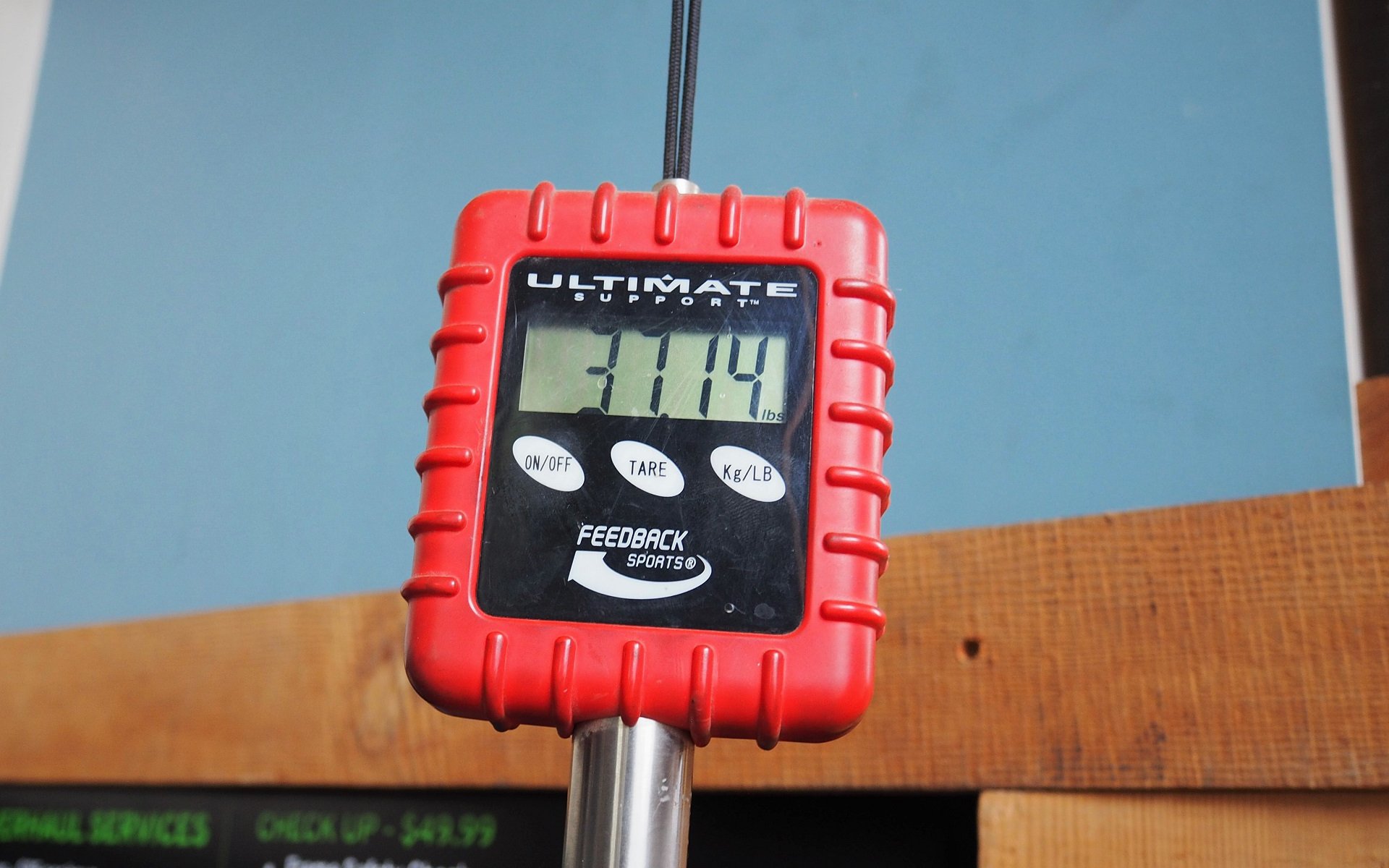
EDITORIAL
The Weight Is Over
Shitty Grams
There are about a billion iterations of this quote and if your frontal lobe hasn't pumped out a rough equivalent at some point you've certainly heard it opined a dozen ways. I'm going to go with "who cares about a couple of hundred grams, just take a big shit before your ride," but I'm certain I've heard funnier, danker, and less appropriate versions. I've also largely lived this philosophy for a decade or so only to find myself reflecting a lot on it in the last few weeks. The impetus is the surprising number of riders I talk to who seem to be suddenly interested in shedding weight off their bikes. Folks I've known for years who until recently were riding DH tires and are now rolling on rubber weighing hundreds of grams less and sporting trail-level sidewall protection.
Now to be clear. I'm not talking about shitty grams. If two products cost the same amount, perform at the same level, and have similar durability and one is substantially heavier, then I'll choose the lighter one. But, I run aluminum cranks so I don't have to think about them failing, a bash guard to protect my drivetrain, CushCore Plus or Pro inserts for the ride quality and run-flat properties, big brake rotors, and a lowered longer travel fork all for reasons I can easily justify. Or maybe, all for reasons I could easily justify.
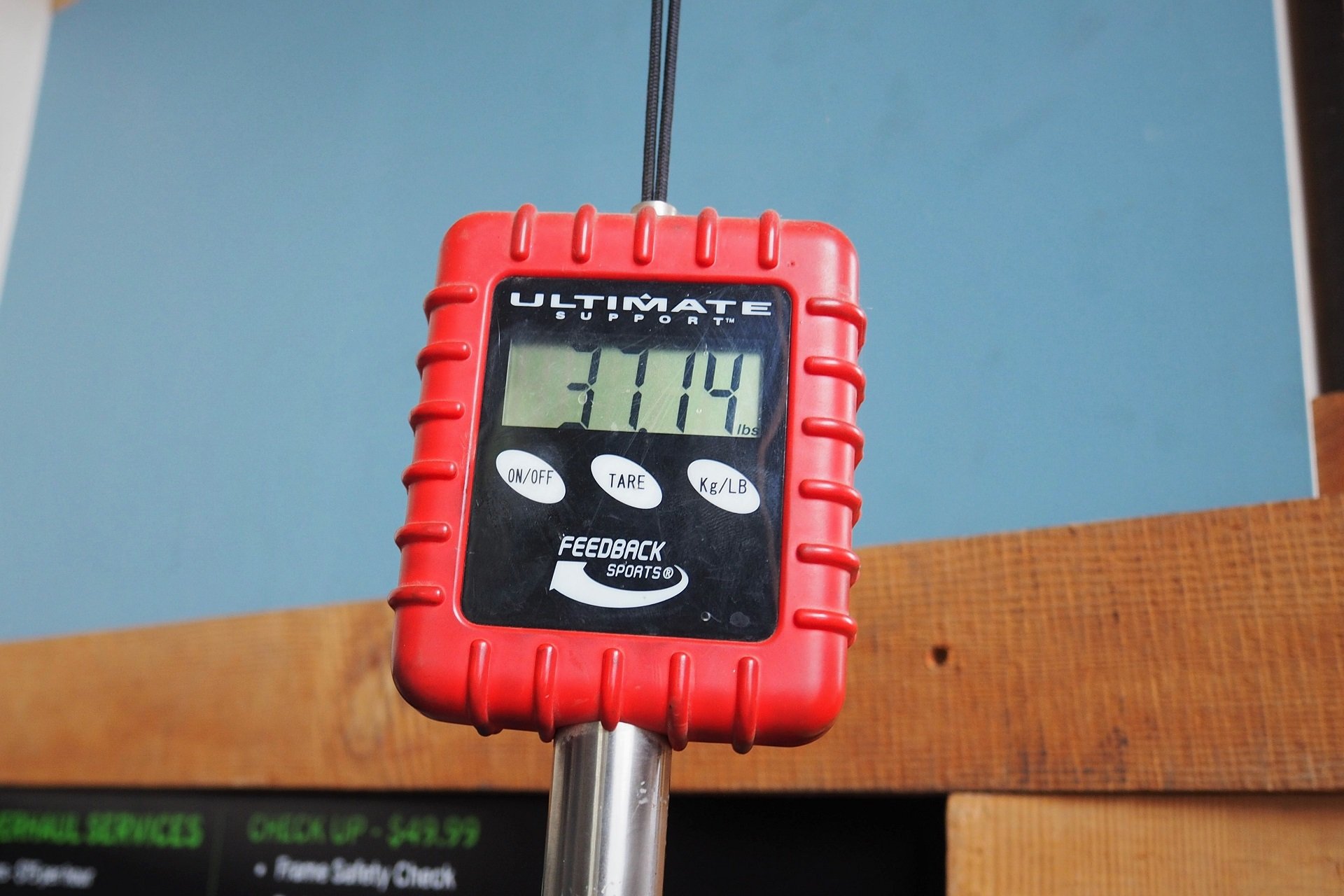
This is the weight of my personal bike loaded up and ready for jank. It includes an EDC Lite tool, EnCase chain breaker, and two full water bottles with cages. (Photos: AM)
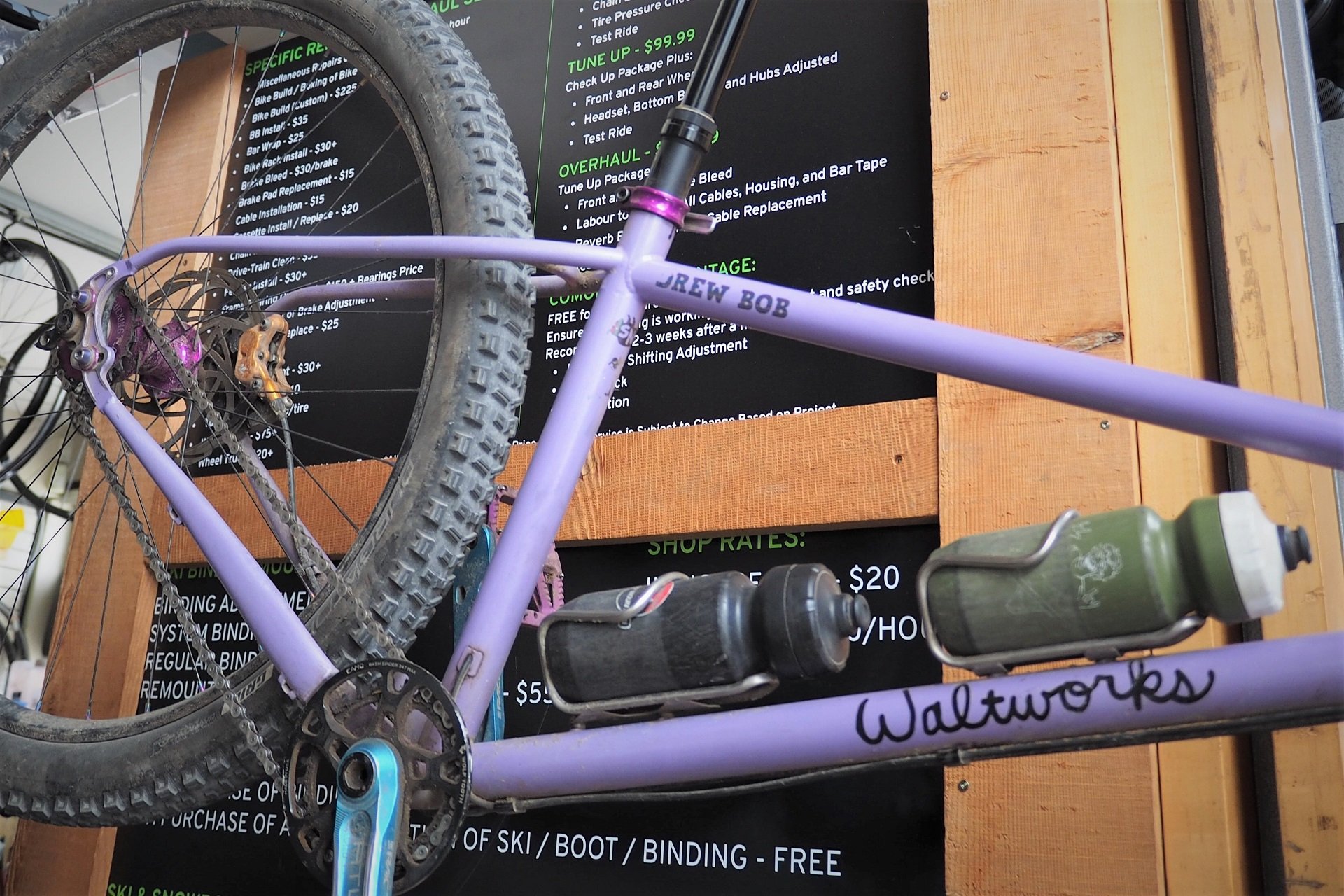
But, it's also missing a rear shock, all the bearings and pivot hardware, 11 gears, a shifter, a derailleur, and the accompanying cable and housing. And it has 120mm travel in the front.
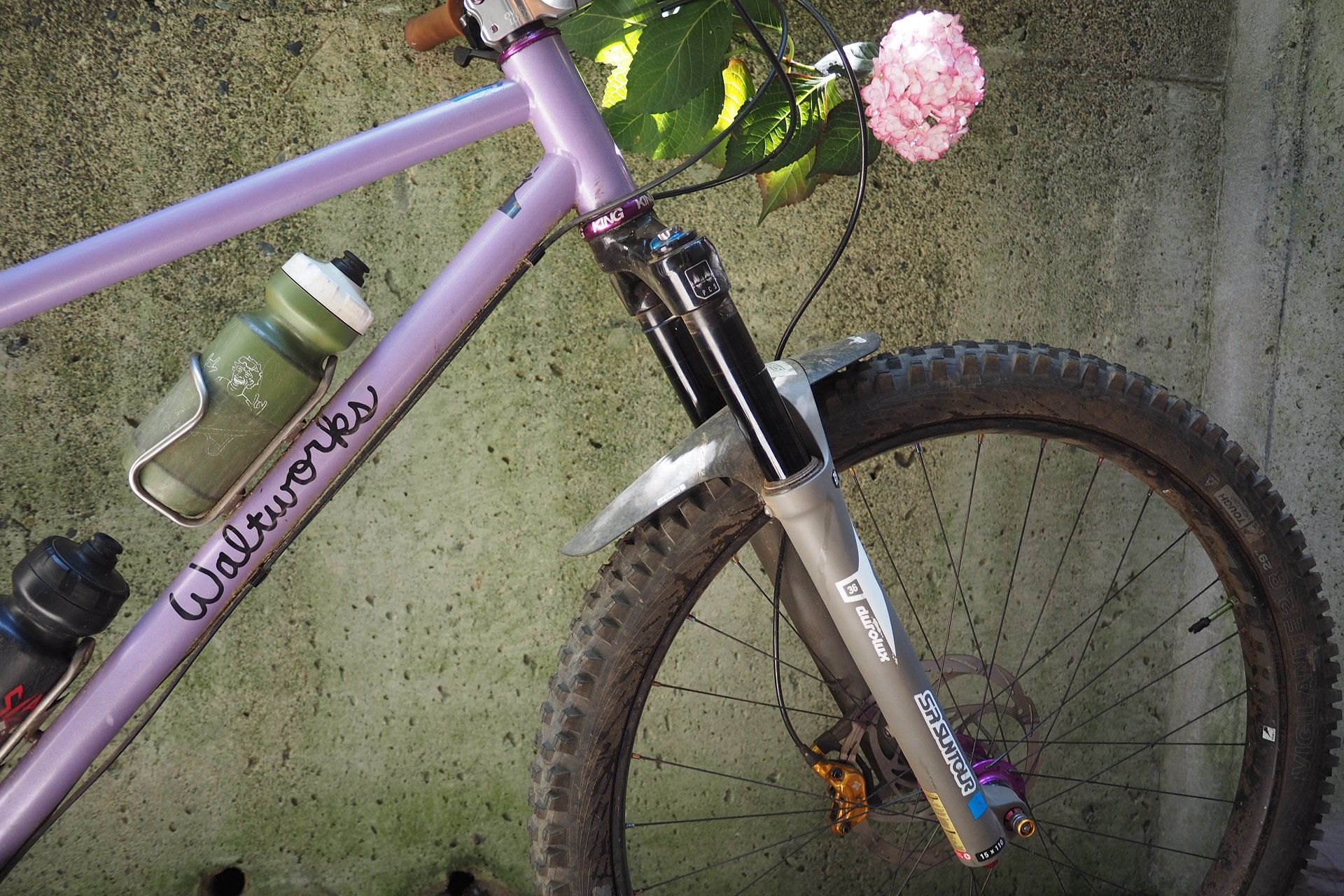
My Walt V2 is a long & slack steel frame built to survive. There are also the no-compromise tires and CushCore Pro, lowered SR Suntour Durolux, and big brake rotors.
Either way, I'm guilty of calling out my friends, in writing, for their opinions on the future of mountain bike trends - for the sole purpose of reminding them in the future. So here I am sharing my short-term future prediction for an abrupt change in the pattern of bicycle and component purchases on Vancouver's North Shore and anywhere else where the riding is chunky and demanding. The 2023 model year is already in the bag with 2024 on the design table so for the purpose of future accountability, let's call this a prediction for the return of mass weight weenieism by 2025.
Either way, I can hear you muttering "get more fit and take a shit" and to a large extent, I agree with the sentiment. But, I predict in the near future the average self-powered mountain biker will be busting out the gram scales and min-maxing weight and performance more often than they have in a long time.
Inevitability
It's no coincidence there have been two articles about weight on NSMB.com in as many weeks. I'm going to start by preparing you for a lot more, here and everywhere on the internet you read about mountain bicycles. I'm not talking about folks drilling holes in their chainrings to save a couple of grams, but rather choosing a slight compromise, or even a large compromise, in performance to account for the size of their meat motor. And while I'm fully aware of the latest lighter weight e~machines, here I'm focused only on plainly person-powered pedaling.
For a deeper dive, I'd suggest starting first with AJ's Weight Vs Geometry, check-in on Cam's experience running the latest carbon XC wheels on his go-to North Shore rig, and there's also some solid discussion in the comments of High Pivot AND Pedaling. Actually, I was just browsing Cooper Quinn's review of the Transition Spur in relation to this piece as well. And that's just the beginning because I'm going to guess there's plenty more indirect and direct discussion of weight coming.
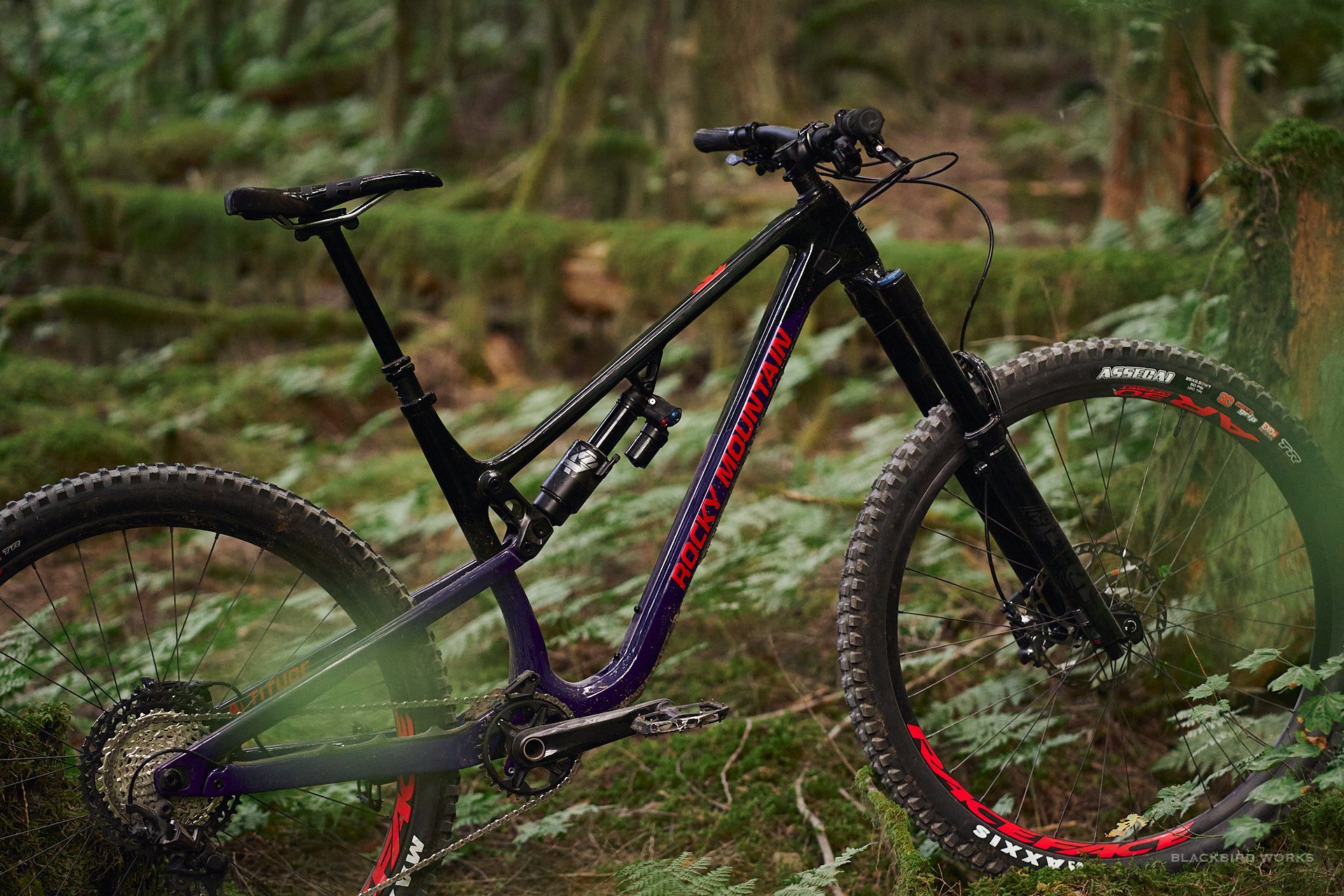
Apples to apples, the Altitude C70 is about 32 lbs. for a size large without inserts or carbon wheels and running a Shimano XT build. The frame is well-proven on the EWS circuit. I see a lot of these bikes running coil shocks which certainly adds weight. (Photo: Deniz Merdano/Blackbird Works)

At almost 38 lbs. for a large with carbon wheels and a lighter, higher end SRAM drivetrain BUT sporting a coil rear shock (still no inserts), a rider is paying a weight penalty for the new Range HPV which arguably serves the same purpose. (Photo: Deniz Merdano/Blackbird Works)
I also want to highlight one very succinct point about bicycle weights past vs present that NSMB contributor Ryan Walters has brought up on a couple of occasions. Bike frames are massive compared to even the recent past. Just looking at my size medium Walt V2 with 450-470mm stays, a 480mm Reach, and a tubeset to support a ~62.5° static HTA and of course, my frame weighs a lot more than the equivalent ride from a decade ago. Heck, my Balfa Minute Man looks like a kids' bike in comparison. Spending for carbon fibre can help offset some of the weight gains in an otherwise apples to apples comparison but someone riding a boutique-build Giant Reign in 2011 shouldn't be surprised if their equivalent Reign 29er in 2021 is heavier.
So as I move forward with my own micro-weenie weight shedding project, my goal isn't to end up riding a machine as light as some of the loosely equivalent bikes I've owned in the past. Rather, I'm considering ways to achieve near-peer performance with my current Waltworks build while reducing weight at the same time and I think this is the tack most riders will take. I won't be going full ship-of-Theseus as I'll be riding the same frame but would you believe I can drop 45 grams by switching my 180mm travel OneUp V2 post for a 150mm version!? Kidding, kidding, but still, 150mm was okay most of the time?
Dual Crown e~Enduro
Two years ago, maybe even a year ago, the rise of the dual-crown Enduro fork may have still been a niche market; however, between folks tired of creaking CSUs and those looking to best optimize stiffness where it matters, and flex where it improves ride quality, I think there would have been a relatively small but solid market for these heavier chassis.
Now, running on the success of the RockShox Zeb, Manitou Mezzer, and the reliably creak-free next-gen Fox 38 CSU (crown steerer unit) and with a host of beefed up single crowns from the likes of Ohlins, DVO, and SR Suntour in the wings, I wonder how the market remains in 202x? Going forward I don't foresee riders choosing the weight penalty of the dual crown, for all but the beefiest riders surely won't notice the performance gains.
For example, the Mezzer is an awesome up to 180mm 29er single crown fork that weighs around 2,050 grams, and the just-launched Dorado Pro is 2970 grams in the same configuration. Comparing the top end Pro models, the Dorado also adds +750 USD to the purchase price. The Dorado Expert takes the price difference down to +400 USD with no loss of performance but at 3120 grams that's an extra 2.35 pounds of weight at the front of the bike.
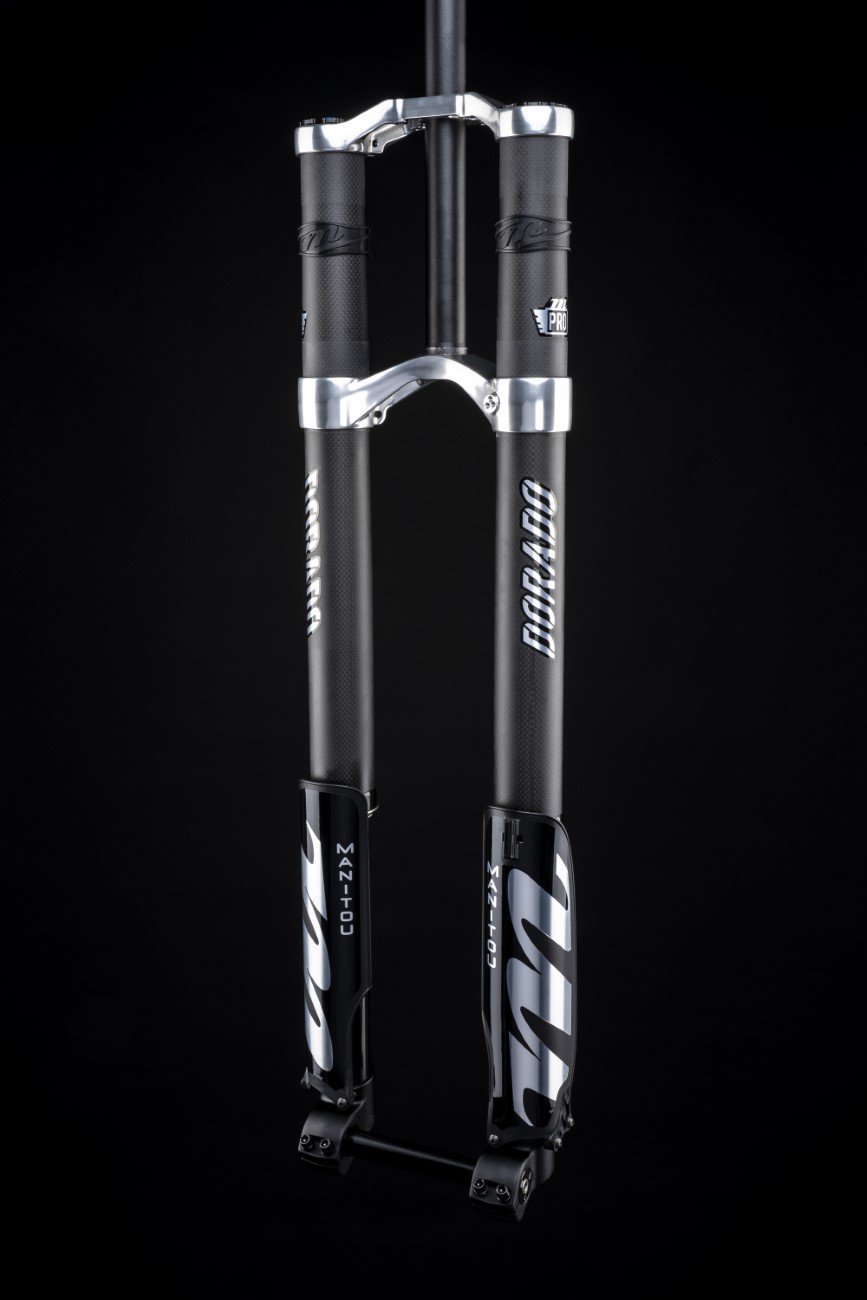
Manitou just re-launched their Dorado fork with fresh internals and a new 37mm chassis. It's a DH fork but with an Enduro and long-travel e~bike upside. (Photo: Manitou)
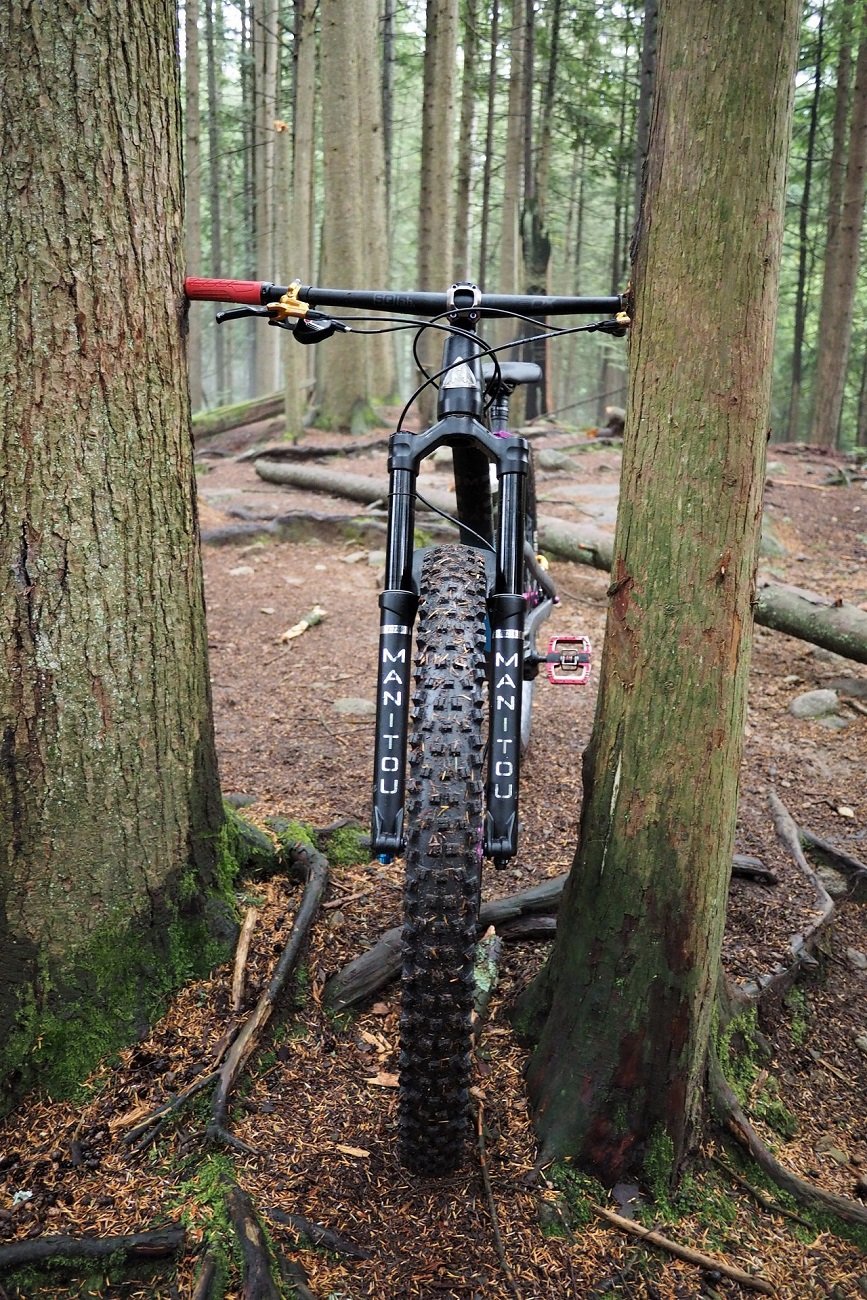
The 180mm Mezzer 29er is around 2050 grams, which makes it some 2 lbs. lighter than the lightest Dorado option. It has both excellent chassis stiffness and ride quality. That's a big weight difference. (Photo: AM)
I haven't ridden the new Dorado but on a lift-assisted DH bike, the Expert would be very high on my personal purchase list based on my experience with the previous generation product. I have a fair few hours on the Mezzer and it's excellent to the point that I can't imagine paying the weight penalty on a bike I'm driving under my own steam.
I think many of these latest single crown forks cycle back to the promise of the Manitou Travis, RockShox Totem, and long travel Fox 36 from many years back. Not to mention the driver behind 1.5" steerer tubes. All the performance from a double-crown fork that almost any rider needs in a lightweight package. The extra steering radius on climbs is just a bonus.
Freeride Lives
I'm just going to pause for a second to say that herein I'm talking about the average aggressive Shore rider, the above-average aggressive Shore rider, hell, even some really f***ing talented mountain bikers going pretty damn huge in our local mountains. But, I'm certainly not saying that there aren't riders who will gladly continue to take any weight penalty to run coil shocks, dual crown forks, and DH tires with full-on inserts.
It's just that as there's been a renewed focus on Freeriding locally - which I'll define here as having fun and going huge with friends - I think we're seeing the same trends as we did decades ago. The average local rider would probably be happiest on EXO tires and CushCore XC inserts - or 'CushCore Trail' as my friend Toucan calls them - but instead finds themselves running DoubleDown casings and a CushCore Pro insert because some of the people they ride with or see riding really do need that level of tire system either because they're going full-send, or they're going full-hack, or some combination of the two.
If you don't make a Stan's Flow rim egg-shaped in a few rides, ruin carbon rims just looking at them, and have tires jump off the rims because you land sideways at a 45° angle every time, then there's probably a tire, insert (or no insert), and rim combination that could save pounds of rolling weight for even a minimal extra risk of failure.

There are plenty of folks hucking big gaps and rolling huge sh*t on the Shore. Some of those riders are going to prefer dual crown forks and DH rubber with full-on tire inserts. (Photo: Deniz Merdano/Blackbird Works)
Where Rubber Meets Rims
I'm coincidentally working on a follow-up to my piece years ago on Plus Tires, so for the time being I'm leaving that aside. I'm also purposely not going to bring under-rubbering a bike into my discussion at the moment so spare yourself from quoting me the massive weight savings and relative survivability of running a pair of 2.2" Maxxis Ikons at 35psi. I also recognize this isn't a perfect argument because many folks run different tires in the summer and winter but then, while an Assegai/DHR2 combo rolls much slower than a DHF/Aggressor combo I'd say the weights are similar enough running the same sidewall and same level or insert.
Either way, the nominal North Shore tire-and-rim combo seems to have averaged out at a 2.5" width, in both 27" and 29" diameters, front and rear with an approximate 30mm internal rim width.
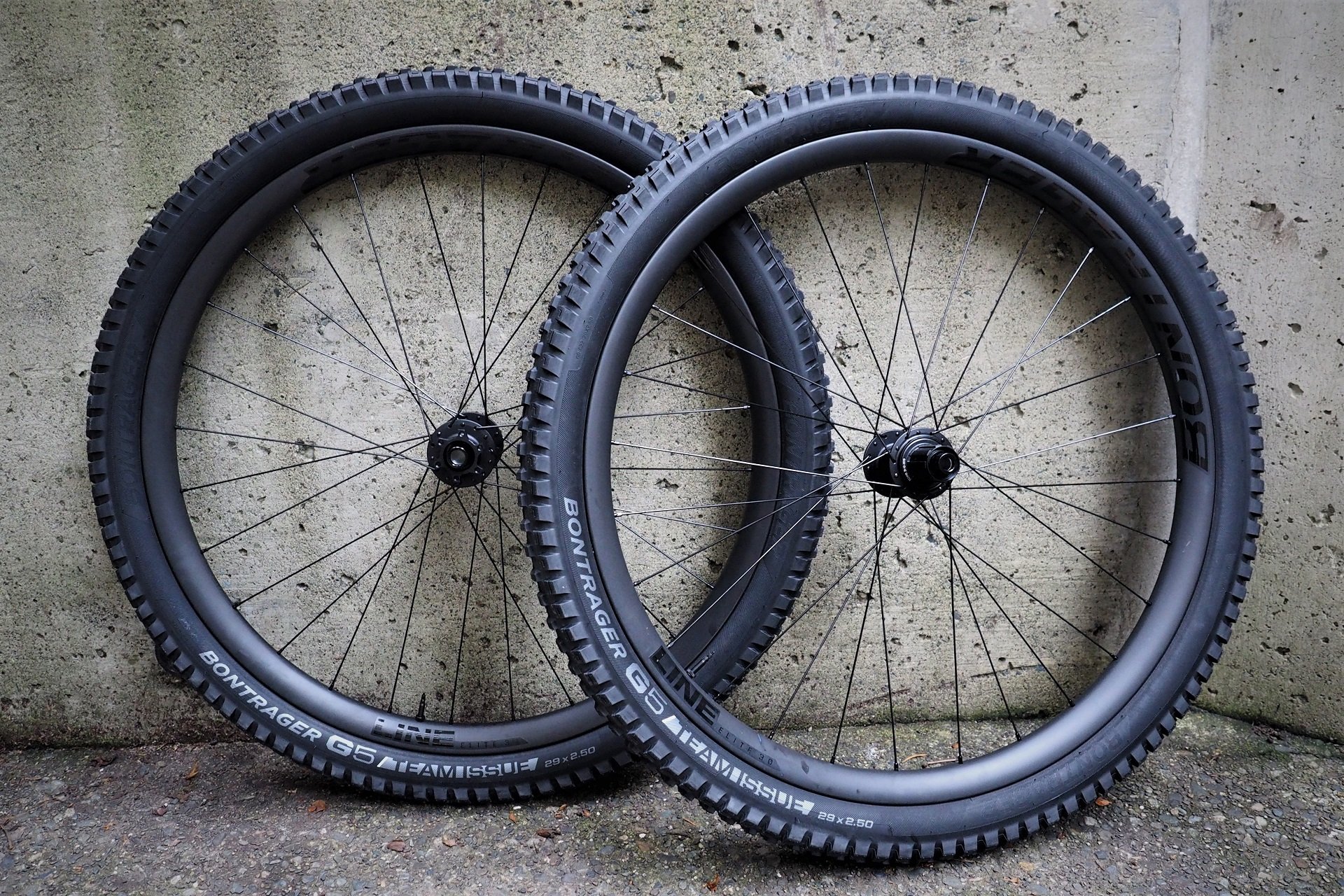
I mention Maxxis models in my piece as they tend to deliver the most commonality of experience. Bontrager's G5 is another example of an excellent 29 x 2.5" tire. (Photo: AM)
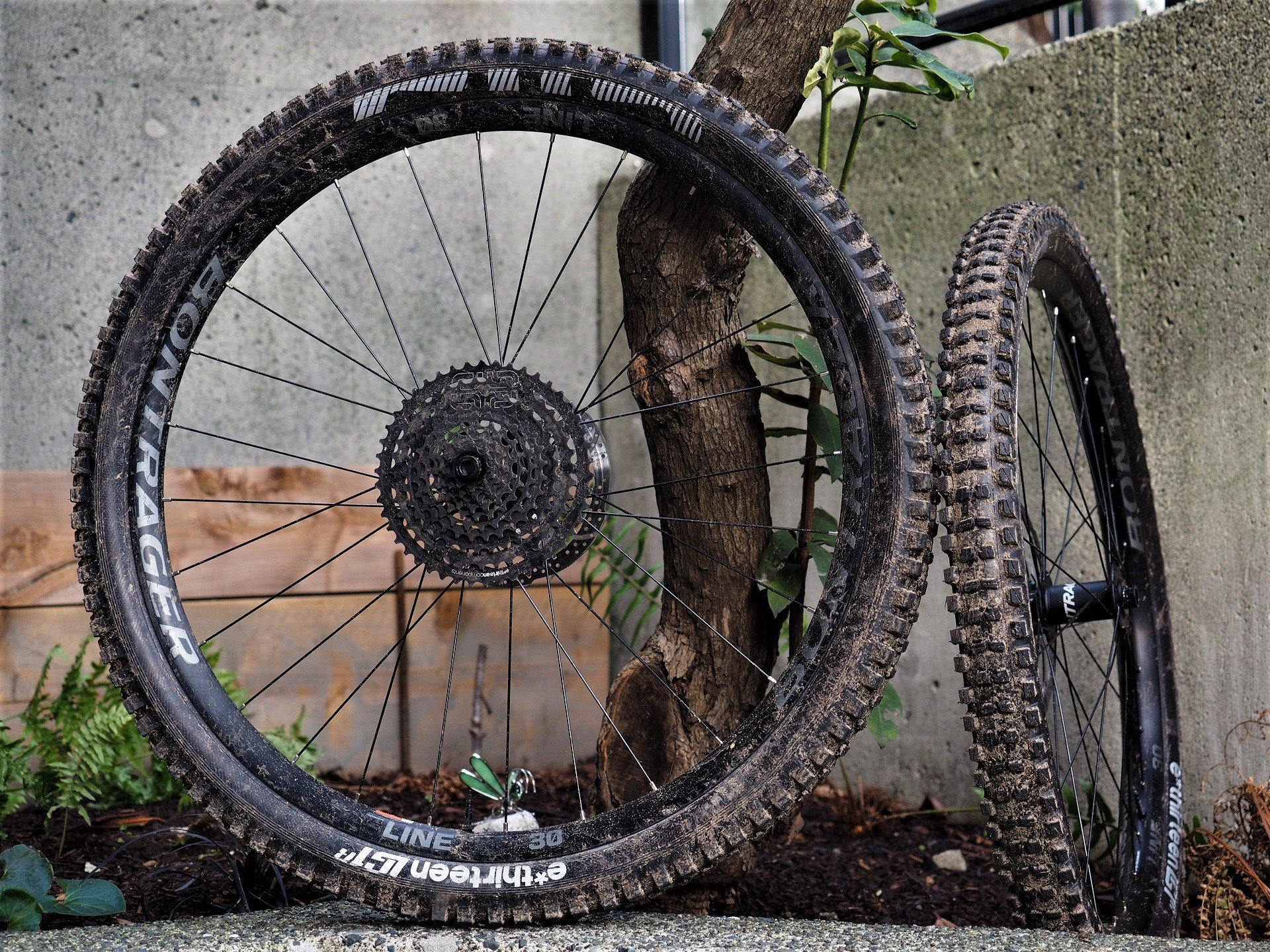
e13 called their tires 2.35", and now call them 2.4", but realistically, as with Schwalbe, they measure similarly to other brand's 2.5" options. (Photo: AM)
The other day a couple of my friends were talking about how much better the Assegai is compared to the DHF and specifically how it doesn't require the same leap of faith when leaned over as a 2.5" or 2.6" DHF does. Not that I don't agree with the assessment, but I think one of the reasons that the DHF became such a popular tire is that in the classic 2.3" size, or even in the larger pre-Wide Tire (WT) 2.5" Maxxis sizing, the knobs all sat significantly closer together and that floatation period from center to side knobs was significantly reduced.
Then I started thinking about the North Shore standard combo of a 2.5" Assegai MaxxGrip, in either EXO+ or DD, mated to a CushCore insert, either XC or Pro, and then popped on to a 30mm rim. Whichever combo of tire sidewall and insert someone is running, and whether that rim is carbon or aluminum - and light or heavyweight example of either - it's going to have a value of XXXX-grams.
If instead that same rider was on a 2.3" tire, whether a DHF or a future Assegai option, with the same sidewall, and the insert was shrunk so that it took up a similar percentage of the tire volume, and the rim was an 25mm instead of 30, that narrower setup would be lighter weight in a straight-up comparison.
Would there be a significant loss of traction? Doubtful. Would there be a significant loss of comfort? On a hardtail, I can only imagine so but on a 6" travel rig? Doubtful again. It certainly wouldn't look as badass but who's looking at their tire as they ride?
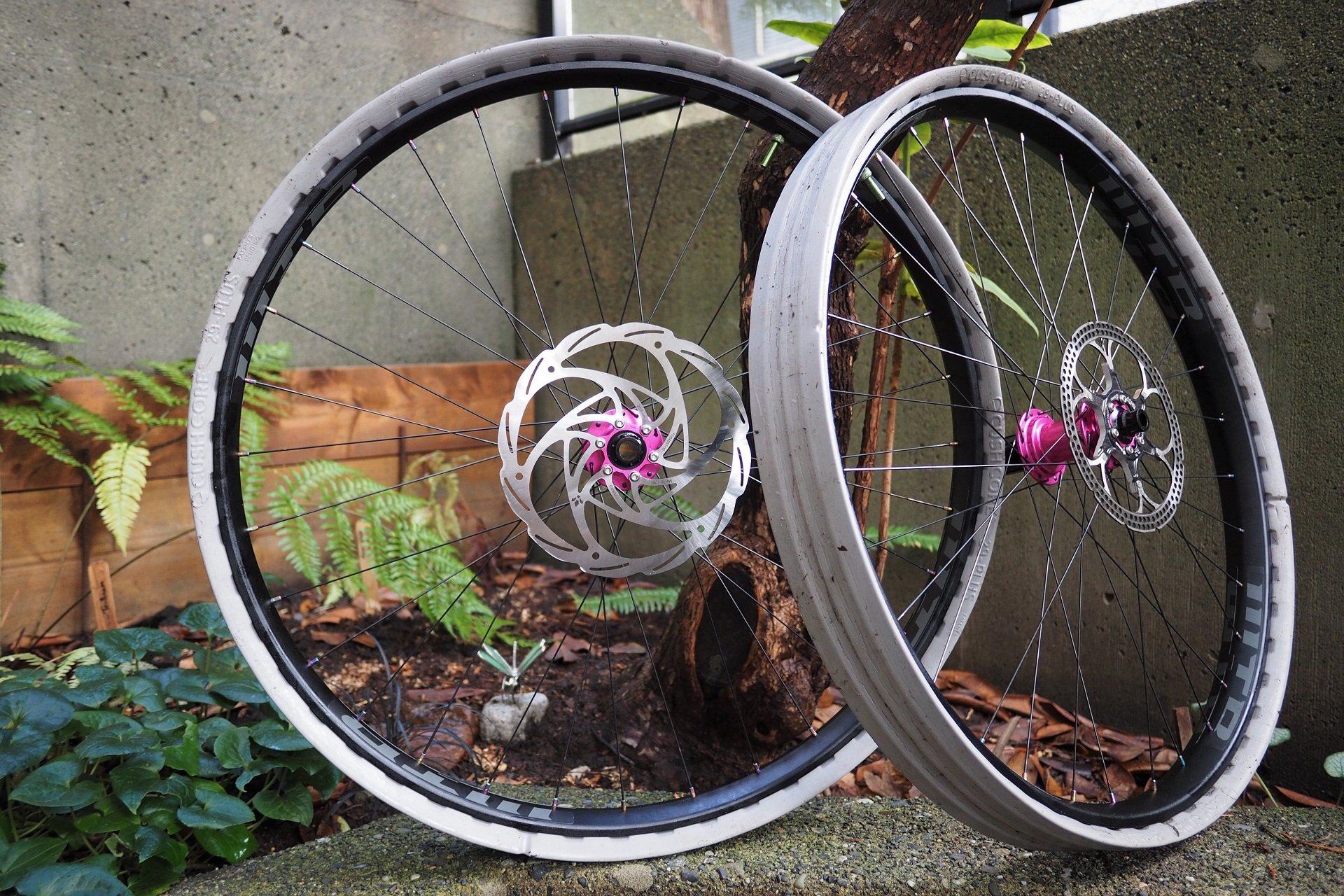
My theory is that with narrower rims and tires a smaller CushCore insert will still provide the same level of run-flat support and eat the same percentage of volume. (Photo: AM)
I've installed a few different inserts for folks lately, all lighter than the CushCore Pro setup I run. And I've talked to a lot of folks about their experiences. Specifically what they want an insert to deliver, what inserts they've tried, and how the performance has measured up. Oh, and one day I saw a dude riding down Mountain Hwy with a pink Tannus insert bandoliered over his shoulder, dripping Stan's sealant, like he was a bike courier delivering used sex toys. I've come to a couple of conclusions.
First, very few people have gotten a flat while running an insert and so most of them don't give a shake about the run-flat abilities of some inserts v. others. That was surprising, as it's a key benefit to me. Second, weight is a much bigger consideration than damping characteristics for a lot of folks riding full suspension bikes and the opposite is true for hardtail riders. Third, many folks choose to just run an insert in their rear wheel for rim protection and aren't looking for a change of ride characteristics at all.
I was pedaling home from a Seymour ride the other day, grunting up a gravel climb, thinking about all that and finally just came to the conclusion that if my only concern was rim protection I'd just ride a beefy set of carbon rims and add a bit of air pressure. That's what I did while testing Bontrager's Line Elite carbon wheels and I suffered zero issues. The big thing for me when running without inserts is choosing a more durable tire casing because all this gram talk aside, it's still my goal to never have to install a tube on a trail again.
Taking A Brake
I've been thinking a lot about brake rotors lately. Specifically, 220mm brake rotors and the accompanying adapters. More specifically, the 2.2mm thick - as opposed to 2.0mm - 220mm SRAM brake rotors that I see on trail bikes everywhere. Maybe those big rotors make sense when in summer temperatures, riding in the Whistler Bike Park, or even doing big shuttle laps when conditions are loose-over-hard. That is, hard on the brakes. But what about in the winter, when speeds are much lower and our brakes are generally water-cooled, and keeping tires rolling is absolutely the key to maintaining traction?
Even now, in the dusty summer, even riding 29ers, I think when folks start adding up grams again we'll see a return to 200mm rotors up front with smaller 180mm rotors in the rear for average-sized riders. Smaller folks can ditch even more grams with post-mount direct-mount 180mm forks by shrinking to a 7" rotor up front.
Now, I'm not planning to start riding SRAM Level or G2 stoppers. It's not about a massive drop in performance to save a couple of grams, for example, the extra 60 grams per side for a CODE brake over the G2, but rather the fact that I think I could still get by happily on most slow speed Shore jank on my Cura 4, MT-5, or Dominion A4 brakes even after stepping down a rotor size.
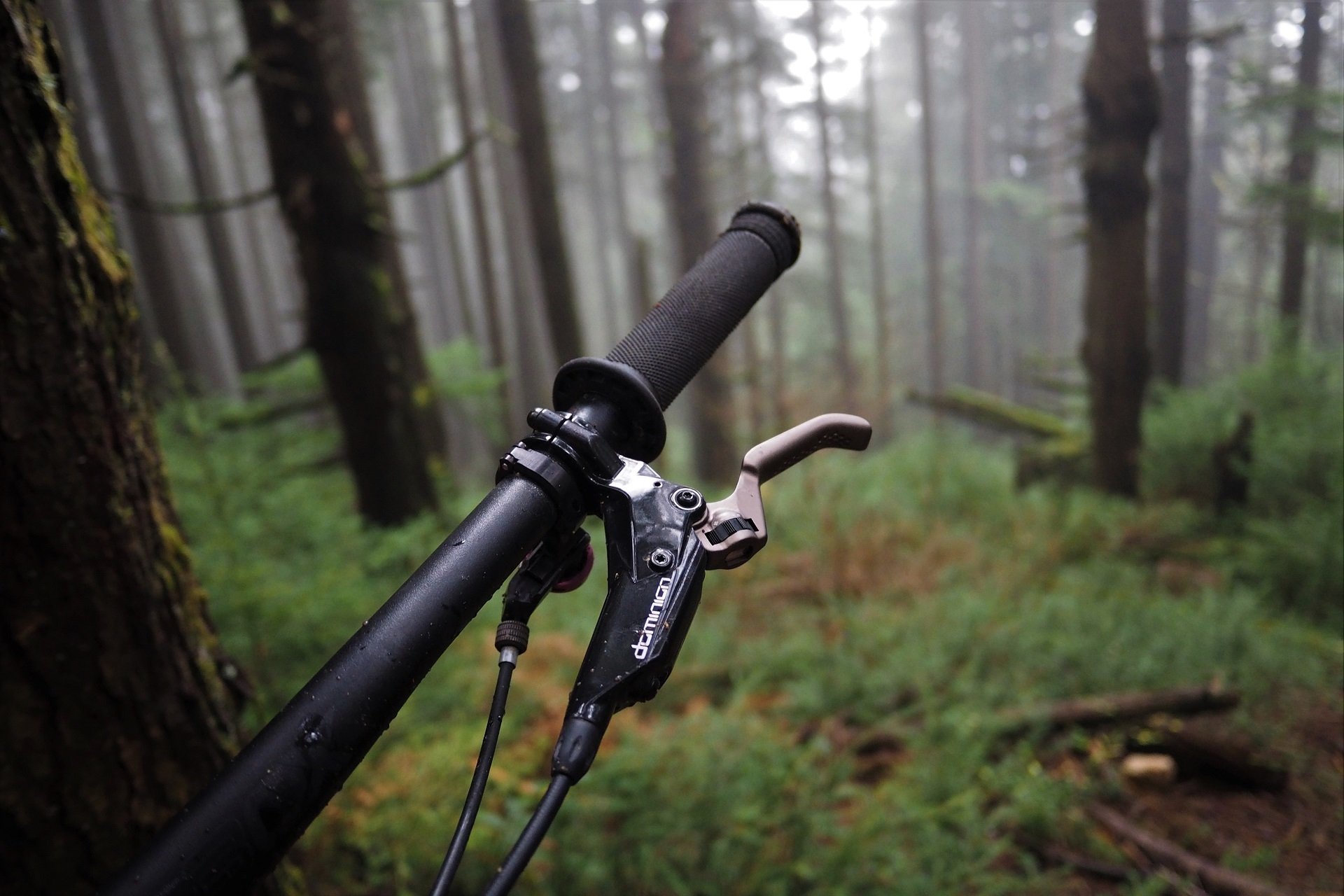
Even with big brakes like the CODE, MT-5/7, Cura4, or Dominion A4, the current trend is towards larger and larger, and heavier and heavier, brake rotors. (Photo: AM)
Still talking about SRAM for the moment. Dropping from a 200mm to a 180mm rotor saves about 50 grams per wheel, not including any weight savings from the adapters. What's another 100 grams right? Look, that's the kind of thinking that has me hitting the trails on a 37+ pound, 120mm-forked single speed.
The biggest issue with dropping rotor sizes is of course heat dissipation and for some riders on the Shore, for a while in the summer, that has the potential to really affect performance. But here I come back to the point about some riders needing DH casing tires with CushCore inserts. If you have issues with brakes overheating or fading ask yourself when was the last time you bled them. If it was recently then consider if they're the right brake for the job. If you're running some WC DH-proven super-stoppers then it's probably time for a larger rotor setup.
It's a theory. With my next set of rotors on the hardtail, I'm planning to run 180mm front and rear to see if I really miss the larger option in practice. The goal is of course not to save 100 grams, it's to stack a whole bunch of 100 gram savings together and see if my favourite mountain bike really ends up any less rideable.
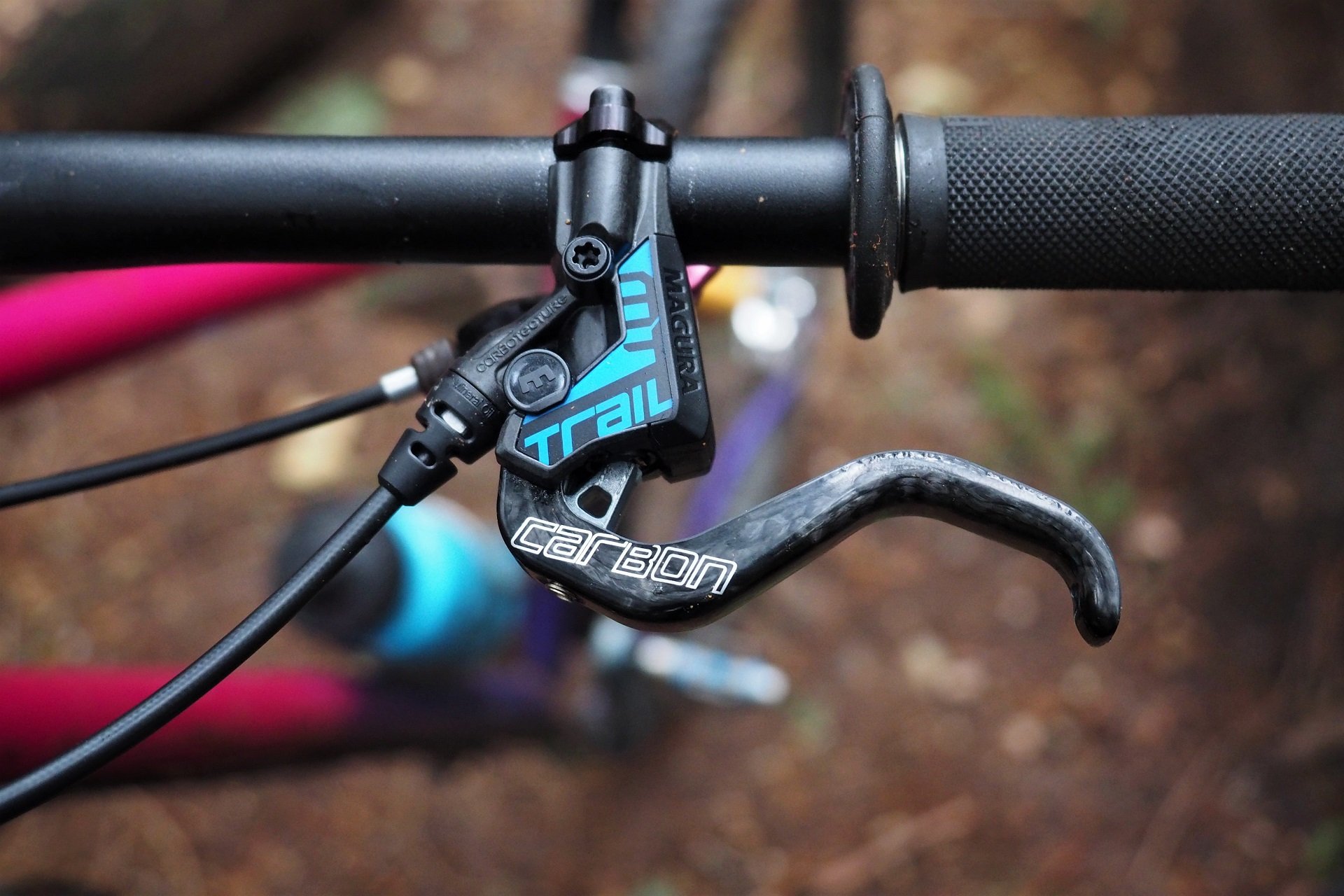
I'm a big fan of the selective use of carbon fibre to improve performance on my bicycle. For example, carbon lever blades in the cold. I don't see myself buying carbon cranks or bars just to shave grams, but who knows where the weight weenie train goes? (Photo: AM)
Nostradumbass
It's not so much that bigger rotors, beefier rims, heavy-duty rubber, double crown Enduro forks, or coil suspension are going anywhere. The gravity market is going to continue to be well-served by the ever-growing long-travel battery-powered experience that more and more riders are seeking.
It's more that I'm anticipating a massive pendulum shift for those choosing to power themselves on the trails. With most riders switching back to air suspension and looking at places they're paying to pack more weight around when a lighter option exists. Min-maxing becomes about more than price v. performance but also includes a look at weight. For example, smaller cassettes with smaller chainrings weigh less and cost no more. A Lyrik weighs a half-pound less than a Zeb for the same travel. And where does it stop? Will riders go to choosing 160mm travel bikes over 180mm travel bikes, and 140mm travel bikes over 160mm travel bikes, and 120mm travel bikes where they would have ridden 140mm bikes as was the trend a decade ago?
Ah, who knows. I'm more than prepared to be wrong on all accounts. But in the past, I've known many mountain bikers who, after having finished shedding the shitty grams, went looking for every bit of weight they could find. Who really knows where we'll wind up riding a new weight weenie wave? At the very least, I think it's safe to expect a myriad of articles, on every media platform, on the subject.
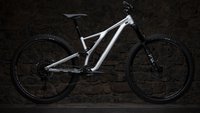
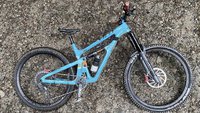
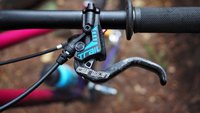








Comments
fartymarty
2 years, 8 months ago
Andrew,
One thing you haven't mentioned is rider weigh. I think bike weigh must be proportional to rider weight. A 30lb bike for someone at 60kg (sorry to mix units) is proportional to a 45lb bike for someone at 90kg. This assumes both riders have a similar muscle %.
Thinking about this more scientificly it makes sense (or at least in my mind). Heavier riders generate more kinetic energy (KE = 1/2 m v^2). Therefore heavier riders are putting proportionally more force into components than lighter riders for the same speed. Components are proportionally stronger as weight increased*. Therefore heavier riders need stronger and therefore heavier components than lighter riders. Therefore bike weigh is proportional to rider weight....
* this is not strictly true as you can increase diameters which increase strength / stiffness without the proportional increase in weight - look at larger diameter thin walled tubes cf smaller thicker walled tubes.
What annoys me is comparing bike weights (a stand alone number) and not factoring in rider weight. Add in rider speed and the equation gets worse.
Reply
Dan Lees
2 years, 8 months ago
Beat me to it!
210lb (6ft1, not overly fat, stronger than most MTBer, dashing good looks) me on a 35lb bike is fine. But it's going to feel heavy AF for a someone who is 140lbs.
I also know that at my "SLX not XTR" level budget I need to favour strength over weight when making component choices, whereas someone who is lighter might not.
Where things get tricky is where you have someone who is quite slight, rides hard/clumsily but doesn't have a big budget. So teens then...
Reply
Geof Harries
2 years, 8 months ago
Apples to oranges, but this summer I've been riding my 25 lbs. XC hardtail a lot. Is it Shore-ready? No, but it's surprisingly capable on at least the trails I tend to ride most.
I have also been riding far less my 34+ lbs. 160mm enduro bike.
After spending so much time on the hardtail, I think I've been spoiled by the nearly 10 lbs. weight difference. It's also caused me to remember the benefits of a flickable, light and efficient bike.
I'm 195 lbs. and 6'3", so moderately big but still am digging the "feathery" setup.
Reply
Andrew Major
2 years, 8 months ago
The “something different” factor can’t be ignored. But I’m one of those who habitually rides the same trails whether on a 7” super sled or a rigid bike so I’d need to change that too to get away with a real XC bike?
Reply
Hank Sola
2 years, 8 months ago
Same here. 25 lb hardtail, 35 lb enduro
I like having both so I can be a weight weenie on one bike and a practical durable choices on the other.
Reply
Velocipedestrian
2 years, 8 months ago
This feeds into the geometry vs travel discussion. Has anyone put an angleset into a Spur yet? Or some similar experiment designed to get Enduro bike geo in a light trail package?
Reply
Andrew Major
2 years, 8 months ago
From what I've seen at some point the theoretical Spur gets so slow and heavy on the way up (tires, component swaps) and even with dialed suspension and big brakes just isn't as capable on the way down. I've come to see the secret with bikes like the Spur is to add the absolute minimum weight in order to stay within the bike's intention in the terrain you're riding. I'd say the same for a Tallboy, Rift Zone, Stumpy, etc.
That's not to say any of those bikes isn't fun with dual Assegais, 200mm rotors, and a 63° HTA. But they definitely require riding on a sharp edge to take advantage of the geo and parts v. a 6" bike with a similar build.
Reply
Velocipedestrian
2 years, 8 months ago
That's what I mean, just change the geometry not the weight of an already light bike.
A tough enough, light enough unicorn.
Reply
Andrew Major
2 years, 8 months ago
Strength to weight ratios are real. Also didn’t really get into comfort v. rolling v. weight for tires. Nice having a 2.6” on the back of my hardtail… will my back be okay with the 2.3”? It’s all in the name of experimentation.
Reply
mrbrett
2 years, 8 months ago
I think the 2.3 should work just fine for you. The best behaved all-round back tire I have used for summertime Mountain Biking (it's a new category of riding you can variably succeed at on any bike) was a 29 x 2.3 DD DHR Maxxterra. Anything I have used over 2.5" has been a floppy disaster on aggressive turns. That 2.3" DHR was supportive, not that heavy, just the right profile, rolled fast, and durable.
Try finding a 2.3" tire in stock anywhere though! Hen's teeth! People need 2.5" at least to ride a green trail.
Reply
fartymarty
2 years, 8 months ago
I've been running 2.3s (WTB and R2s) for a while now and like them on a 30mm rim. I've been told mtb is an "edge" sport therefore the quicker you can get onto the edge of the tyre the better.
Edit- I'm running a 2.25 trail boss on my HT with no back issues yet.
Reply
MuscogeeMasher
2 years, 8 months ago
I really like 27mm rims and 2.3 dhf and aggressor on my trail bike (the dual compound rear is fine for my climate and trails). Tannus tubeless inserts.
At 205lbs I’ve got 2.5/2.4 on the bigger bike (dhr rear). To rift off fartymarty’s comment re bike and rider weight, I’ve always thought a bigger, heavier rider should run a slightly more aggressive tire. If a 140lbs person and me go through a corner at the same speed, I think it’s accurate that I’m asking more of my tires.
Reply
taprider
2 years, 8 months ago
Highly agree about the weight of the rider being a gigantic factor.
I know some ~130 lb teenage XC racers that can ride all the hard lines and jumps on the legal Seymour trails at speed with their race bikes with XC race tires
Reply
taprider
2 years, 8 months ago
As well, the styles and skills, of different rider types, develop according to the tools they use. An Elite XC racer may be equally as fast as an Elite DH racer for Fiver Enduros, but they ride in different ways that maximize the benefits and minimize the handicaps of the equipment they use.
Reply
sverdrup
2 years, 8 months ago
I have been following your articles here (and your personal blog) for a long time, as I have found your writing more insightful than most. Thanks very much for your contributions.
Given that, this article strikes me as a hard left turn for your opinions on durability versus weight, and how that relates to performance (recognizing this is a loaded term that means something different to us all). I don’t necessarily disagree with anything you have written here, but I am left wondering what has changed/motivated you to reassess your own setup in this way? I have some guesses, but I am curious to understand your thought process. I personally have found the way you write about your own reasoning through this pastime the most enjoyable and relatable, and hope you might address that?
Reply
Andrew Major
2 years, 8 months ago
First, thank you. Much.
My first thought when I’m writing anything is I’d like it to interest and entertain. I like to hope that whether it’s a piece about night riding, single speeding, or something a reader may never choose to pursue, or a review of a product they would never be interested in, maybe there’s enough extra value that they’ll enjoy what I’ve assembled anyways?
In general terms, this is both a reflection of what I’m hearing and seeing and some food for thought. I think of it as one side of a discussion maybe we’d have over a beer and the other side is in the comment section. Actually, I was reading Perry’s response and picturing us sitting at Beere talking with our hands a bunch about Ti bolts.
In personal terms I have a few things that have come up. I have some repetitive/awkward motion issues from my part time gig wrenching that I’m managing. The most obvious result being you’ll rarely see me on a rigid fork these days. Not that I don’t still love “ripping” down Pipeline on my rigid, or that rigid isn’t #1 in my heart, I just have to pick my battles if I need to turn wrenches tomorrow. Without the rigid fork I don’t need a 2.8” tire anymore so I’ve been playing with narrower options.
I’ve also been doing a bunch of much longer rides this summer with lots of gravel and pavement AND gnarly trails and then more gravel and pavement home. It’s had me thinking a lot about min-maxing my setup. I’m not running Aspens on i23 carbon race rims or anything crazy. But, with a narrower tire and a smaller insert taking up a similar percent volume maybe I can make those less aggressive miles easier and stay fresher for the trails? I’m certainly not inviting equipment failures into my life (I hope), just doing some thoughtful experimenting with my favourite ride and I figured it might make for interesting reading.
I do absolutely believe that there will be more stuff written in the next two years about counting grams than the last ten, and I’ll exclude myself from the tally since I know I have a few more pieces in the pipe. Bikes are so good and geo changes have slowed so I think we’ll start seeing weight as a selling feature again a lot.
Cheers!
Reply
fartymarty
2 years, 8 months ago
Jumping in here I think it's good to document our (collective) current thinking(s) on weight and component choices for future reference and I appreciate NSMB for allowing this to happen with the recent articles focusing on weight.
I guess the big question is "is bike weight really an issue?". I think unsprung weight makes a big difference in how a bike handles but sprung weight less so.
Reply
Andrew Major
2 years, 8 months ago
One interesting note that came up in the comments for tires is weight v. drag. Certainly, I've been running a fast rear tire that has a surprising amount of grip (Specialized Purgatory) rather than a grippy rear tire.
This piece is intended as a conversation starter - I think it's been successful - and I'll certainly be playing around with rolling weight more than anything.
Reply
JVP
2 years, 8 months ago
Interesting thoughts. Where I live (Seattle) our high quality backyard ride options are getting longer and longer with new trails coming online. A lot of the hard charging DH (or is that freeride? or enduro? or trail? I'm so confused!) riders are seeking out long rides. Our average ride has to be twice the vert vs what we did 6 years ago. Our tire choices have swung lighter recently, you don't see much DH rubber anymore, and you see a lot of Tannus or similar lightish rear inserts to prevent pinch flats at medium pressure.
Not a lot of obsessing over general bike weight, but we absolutely do try to find tires that don't feel like you're climbing through sand.
Reply
Andrew Major
2 years, 8 months ago
This is exactly what I'm thinking about from my perspective. Even if I'm a bit slower on the aggressive trails overall my ride will be much more enjoyable on tires that roll nicely.
Reply
Vik Banerjee
2 years, 8 months ago
I built a carbonium lightweight wunderbike as a challenge project. It was what I would call a BC "All Mtn" ride...which now we are calling enduro I guess. Sort of like what we used to call "XC" is now "Trail". Fun project. A bit expensive, but I had no failures over 4 years of riding it.
Next bike was all metal dual coil with the same mission statement to ride anything I dared ride in BC. It weighs ~7lbs more and I don't notice any real differences in performance. I have PRs up and down with both bikes that are close enough I'd call it a wash. They do ride different so they are not exactly the same, but any ride I'd do on one I'd happily do on the other.
The carbon bike was sold and I'm on heavy metal rigs at the moment FS & hardtail. I'm sort of thinking about another light weight bike in the vein of an Ibis Ripley or something like that. Sort of like a suspended hardtail. If I were to do that I'd bling it out with carbon parts and get it back to several pounds lighter than my dual coil rig. I wouldn't fool myself that it would make me a lot faster or really better in any way, but it would be a fun project to build and provide a different ride experience.
I also may not bother and just stick to enjoying my steel hardtail or aluminum FS bike depending on my mood.
If I were to really care about ride speed I'd focus on tires will less rolling resistance as that's the one area where I can see/measure a noticeable difference at a modest cost for change/upgrade. I've typically bought tires that are a good mix of traction and rolling speed vs. going max-traction or max-speed. Neither of those options have made sense to me given my limited m-bike [meat powered bike] motor power/battery capacity and increasing disdain for driving to the trails to ride a m-bike or sliding to my death on XC slicks.
Reply
Tjaard Breeuwer
2 years, 8 months ago
Yep, I feel pretty similar,
Reply
fartymarty
2 years, 8 months ago
I've just measured my XL Murmur - 41.8lb with the following build:
Ohlins coils both ends, 511 rims on Hopes, 2.3 tough Vigis (no inserts and about 60ml of sealant per tyre), Zee cranks and calipers, XT levers, shifter and chain, Saint BB and mech, 180mm PNW dropper, Hope HS and seat post clamp, Chromag Trailstar LTD and Ranger stem, Ergotec 50x12 bars, Burgtec Composite pedals, Shimano 11-42 10 speed cassette, Wolftooth stainless 32t chainring. RRP mudguard (front), 44 designs bash guard, Funn top guide and STFU trail guide, B-Rad tool bag (full including 60ml bottle of Stans), 750mm waterbottle on SKS cage.
Reply
Hank Sola
2 years, 8 months ago
I have found one place where you can spend less, and lose weight with (so far to me) zero drawbacks.
Plastic/Composite pedals.
And they are rotating mass.
I love my OneUp composites
Reply
Perry Schebel
2 years, 8 months ago
i don't run flats any more, but when i did, loved my plastic pedals (nukeproof). achieving the very rare trifecta of: light, cheap, strong - pick all 3. wish there were more bits like this. my choice of a compact 11speed drivetrain is a nod in that general direction.
Reply
JT
2 years, 8 months ago
One of the rare exceptions to the Rule, and yup, all over mine. Bonus, they don't transmit cold as well in the long dark winter months.
Reply
JT
2 years, 8 months ago
This comment has been removed.
Andrew Major
2 years, 8 months ago
Love the OneUp composites - absolutely my baseline testing other flats.
Installed a pair of NSB Daemons the other day and they're gorgeous with unique pins and tons of grip. Can imagine running them for the next decade and that'd be worth a few grams to me.
Reply
goose8
2 years, 8 months ago
Good stuff! I'm interested to see where this goes. I jumped on the "smaller cassettes with smaller chainrings" train this spring and it worked really well. The only downside I noticed was increased chain slap since the chain was closer to the chainstay. That was only in smaller cogs though, and on most rides I don't use those too much.
Reply
Andrew Major
2 years, 8 months ago
Some strategically placed Sugru will solve that extra bit of noise!
Did you happen to measure, or guesstimate, how much weight you saved between the cassette and smaller ring? Never mind that the smaller cassette (apples:apples) is shaving unsprung weight.
At this point I'm not considering anything silly like ditching my bashguard and leaving my chain & ring exposed (which actually could shave a lot of weight if I replaced my stainless steel CAMO-Bash assembly with an aluminum ring - oops). Actually, so far I've only added a bit of weight since I put my bike on the scale! But I'm always looking for a project so I'll revisit this a bit ongoing and then submit another look in a few months.
In the meantime, it will be interesting to see if my prediction comes true. That is of course that Weight starts becoming a focus on all sites all the time.
Cheers!
Reply
Perry Schebel
2 years, 8 months ago
a side (potential) benefit to a compact drivetrain, is with improved bb clearance (i run a 26t chainring), i've not found any need for a bash. and run sans guide, for a pretty minimalist, problem-free drivetrain. tho big brakes, reasonably stout tires, and a robust alu frame still add up to a 36lb 140mm "trail" bike. *shrug*. despite previous adventures in weight weenieism (ti & carbon everything / questionable choices), i've come to the realization that it really doesn't matter that much (at least to justify significant sums of $ or compromise performance / reliability).
Reply
Andrew Major
2 years, 8 months ago
I’ve thought about that quite a bit actually… semi-micro driving my single-speed. I think the smallest oval rings are 28t though so I don’t gain much going down from my 30t.
Yeah, certainly not into dumping the my kids’ college monies into unobtanium, just playing with making some smart choices with hopefully minimal performance impact.
Reply
goose8
2 years, 8 months ago
Good question Andrew. I didn't weigh anything when I was doing the swap, but here's what I found online:
Previous setup: 28t oval ring (54g), 11 speed sunrace 46t cassette (570g), DT Swiss steel freehub body (to minimize notching - 107g) = 731g total.
New setup: 26t oval ring (52g), 11 speed SRAM gx cassette (393g), DT Swiss XD freehub body (39g) = 484g.
Savings of ~247g, primarily from the cassette. I suspect I lost a few grams by having a slightly shorter chain, but didn't include that. If you could also run a derailleur with a shorter cage, then that would be another bonus.
I was going to make the same point that Perry did- the clearance you gain running a smaller front chainring is significant. Turns out that it's the bashguard itself making contact much of the time, and if you run a smaller chainring alone you can clear way more obstacles. Absolute Black makes a really nice 26t oval direct mount chainring btw. Aluminum, but I've gotten a lot of riding out of mine and I don't feel like it's an unreasonable compromise on the durability front.
Reply
Andrew Major
2 years, 8 months ago
Cheers for the heads up on the AB ring. Going to do some gear calc/gram calc tonight.
Sun Hester
2 years, 8 months ago
Currently I'm building a new Spur for lighter trail duty's than my main rig and I went with new 11 speed Sram (XX1 cranks, X01 derailleur & cassette, GX shifter)
It saved over half a pound compared to 12 speed in the most important place not to mention significant $.
However I wouldn't want a 42t 1st gear at the 'shore or on my home trails where I go with my AM bike but my theory is that with such a fast light bike on pretty fast rolling tires (and running a 30t front as opposed to my usual 32t) and the lighter duty trails I to use the bike on, that the 11 speed will be adequate.
Shoreboy
2 years, 8 months ago
You can definitely get oval 26T rings. Wife had an absoluteBlack on her bike before she got a wider range cassette.
Reply
Andrew Major
2 years, 8 months ago
Yeah, I think they might be the only one? Learn something new every day!
Cr4w
2 years, 8 months ago
An oval at 26 would be comically small. But if you don't need those bigger gears going micro is a great way to go. I ran 28x11-36 on a bike for a while and it was really good. It looked odd on my super XL bike but it was very practical for the way I ride.
Andrew Major
2 years, 8 months ago
This would be for my single speed so I’d just be achieving the same gearing by going small front and rear.
Vik Banerjee
2 years, 8 months ago
I hate the feel of narrow rubber even on my FS bikes. I've settled on Maxxis 2.6" on 30mm IW rims or 2.5" actual measured tire width on those rims from another brand. Actual 2.4" width was too little volume and actual 2.6" width was too much volume [on my FS bike anyways]. I've warmed up to a Tannus Tubeless insert on the rear of my HT, but haven't seen the point on my front wheel or either wheel on my FS bike. I'm one of those riders just looking to avoid rear flats/rim damage...which only seems to happen with my HT.
FWIW - I've found the rare flat I do get [once or twice a year in a non-insert tire] can 95% of the time be fixed at least temporarily with tubeless plugs. I can't recall putting in a tube in my own bike in so long it's hard to remember when that happened last.
Reply
Andrew Major
2 years, 8 months ago
Plugs are great if there’s sealant in your tire. And can work if it’s dry. So fairly hit or miss for quite a few folks I know.
At this point I’m just experimenting with my hardtail. I’m prepared to hate the 2.3” rear and run that on an FS bike instead.
Reply
Vik Banerjee
2 years, 8 months ago
If a rider can't maintain sealant in their tires then there is no point really having any detailed tech related discussion with them. You should just be glad every time they make it through a ride without a major mechanical.
Reply
Reed Holden
2 years, 8 months ago
I'm in agreement with the idea that I want to be able to run all my bikes on the same trails. This includes hartails and squishy bikes. This being said, I've been experimenting with various rubber combo's on different bikes. I think more important than size of the tire is the aggressiveness of the lugs. I have a 2.5 aggressor and 2.6 rekon (both with cc pro inserts) on one bike and find that one way more skittish than when I run 2.3 minions on it. The smaller tire is more supported by my cc pro insert and I can get away with low pressure still. I am not keen on more narrow rims though. My bikes all have cc pro and the one with rims less than 30mm wide needs 5-7 psi more in them than all the others. 30mm is the sweet spot IMO.
Reply
trumpstinyhands
2 years, 8 months ago
Please please please lets not go back to the bad old days of endless scale shots on forum posts ;)
I run a 220mm rotor on the front of my hardtail. It was more to do with getting as much power out of my G2 RSC brakes for the steep slabs around here than anything else. It was much cheaper than replacing my brakes. In the Park, my 180mm rear rotor goes black pretty fast but the front doesn't discolour at all.
Reply
Andrew Major
2 years, 8 months ago
Hahahaha.
Yeah, there are some arguments that for heat dissipation it makes sense to have a larger rear rotor.
I’d also probably run 220mm rotors with G2 brakes. If I was SRAM I’m kill the Level, make the G2 my modern-XC brake, make the Code my ‘every ride’ brake (which it already is), and then release the Monster-Code for big bikes.
Reply
Cooper Quinn
2 years, 8 months ago
No no. Level has to stick around because German and WCXC exist (also, they might as well keep making it, as the caliper/master cylinder is the basis for many of the road/gravel brakes).
Kill the G2, keep the Code as the do-everything, make a full on f-off DH brake (Monster-Code)
Reply
Cooper Quinn
2 years, 8 months ago
This comment has been removed.
mothrock
2 years, 8 months ago
Great article, once again.
I think you have to consider physical effort when comparing rotor size and their weight.
Big rotors = more leverage = less tiring
I'm around 195lbs dressed and I can't imagine anything less than a 200/180 set up.
Addtionally, I think that upsizing rotors is a great first place to start before upgrading your brakes.
Reply
Andrew Major
2 years, 8 months ago
Absolutely upsizing rotors helps manage less-powerful brakes. Say 200mm G2s v. 180mm Codes, I'm still taking the Codes every time.
Reply
MuscogeeMasher
2 years, 8 months ago
I’ve always found the power and lever feel difference between between G2s and Codes pretty shocking for what, to my nonprofessional eyes and understanding, are fairly minor differences in design. Am I off base here?
Reply
Morgan Heater
2 years, 8 months ago
Breaking stuff makes me mad, sad, and frustrated. I will slowly grind a heavy bike up a big hill if it's less likely to require me to get out all the tools when I get home. Although, I just turned the heaviest hub to sand, so c'est la vie.
Reply
Dogl0rd
2 years, 8 months ago
Same! I'd settle on heavier everything if it means I can just ride and not think about breaking stuff
Reply
Andrew Major
2 years, 8 months ago
My goal in playing with weight is to shed grams without getting exotic and not inviting any abnormal mechanicals into my life.
Onyx hub?
Reply
goose8
2 years, 8 months ago
Tell me more! Heard good things about the engagement and reliability, but do those benefits outweigh the extra mass?
Reply
Andrew Major
2 years, 8 months ago
I was asking if that’s what he turned to sand.
Reply
goose8
2 years, 8 months ago
Ah, I see now. Whoosh! Thanks
Reply
goose8
2 years, 8 months ago
Ah, I see now. Whoosh! Thanks
Reply
Morgan Heater
2 years, 8 months ago
Yep, Onyx classic. It looked like the sprags basically ate the freehub axle and then the whole thing turned into a fixe.
Reply
Andrew Major
2 years, 8 months ago
Yeah, I've seen it before. The good folks at Alba can do a full re-and-re for you.
Reply
Morgan Heater
2 years, 8 months ago
I pulled out what was left on the inside of the hubshell body and the clutch, and the hub shell body was also showing serious signs of wear. Pretty weird. I serviced the hub about 6 months ago, and used the silly expensive grease they specified, but there was no warning that it was failing until it stopped working. I'm going back to hope, affordable and easy to service.
Reply
Andrew Major
2 years, 8 months ago
If you're open to suggestions, check out the Industry Nine 1/1. They're very nicely made, have 4° engagement, and don't have a big hunk of plastic holding the drive system together.
Don't have to spend Hydra money to get a sweet up from I9.
Andeh
2 years, 8 months ago
I think you hit the nail on the head where once you start prioritizing performance and reliability, weight just goes out the window. I still have frustrating conversations with newer riders (or riders on bikes from 1-2 generations back just now looking at upgrading) who obsess over weight without thought of performance. My Megatrail is sitting just under 35 lbs right now. I had a Nomad 3 a few years back with similar build intent that was only 30. Not only has stuff gotten heavier due to getting more reliable, but bikes themselves have gotten larger and therefore heavier. It's basically to the point where if I really wanted a lighter bike, I'd have to replace the frame (with something that probably is less durable).
I'm also sure there's a lot of us who put stuff on for limited use and just never take it off because we're busy. I dropped a chain casing a jump a couple years ago, so promptly put on a chainguide (and will never know whether I really need it). A few weeks ago, I upgraded that chainguide to a bashguide because I was going to ride somewhere really rocky, and probably won't get around to taking it off until this winter. (I did come back from that trip with a nice ding in said bashguide, so I feel somewhat vindicated about that one.) My EDC pump is still strapped to the frame from that same trip (and was also used), and is also unnecessary for my local trails. I have a set of MT7s that are roughly 100g lighter than the Codes I replaced them with, simply because the MT7s have some stubbornly sticky pistons that I got tired of trying to fix. My EXT fork was a splurge/frustration purchase because I was sick of creaky 36s, and weighs a ~250g more than a perfectly functional Lyrik or similar 160mm fork, but no way it's coming off now.
Reply
Andrew Major
2 years, 8 months ago
35lbs for a Megatrail doesn't sound at all overweight/insane.
What hubs/rims or wheels are you running? What sized rotors? What cassette? What tires? Inserts?
Cheers,
Reply
Andeh
2 years, 8 months ago
WAO Unions with Hydras. 200mm rotors. X01 cassette. DD Dissector & EXO+ Assegai. EXT coil.
It's a great build, but when I look at each component, I'm like, "Yeah, that's the right choice." Then my buddy tells me his SB165 is 33 lbs with really similar components, and I'm like WTF.
Reply
Andrew Major
2 years, 8 months ago
So if the Hydra isn’t the lightest high performance hub it must be close? WR1 rims aren’t pigs. X01 Cassette is lightweight and long lasting. EXO+ tire = those all sound like exactly what I’m talking about here.
If you got swapped the EXT Coil for a Float X or a TriAir or etc how much weight would you shave?
Reply
Andeh
2 years, 8 months ago
Yeah, I could drop ~275g running a DPX2 or Super Deluxe instead of coil. Likewise a Lyrik instead of the EXT would drop about 300g. 100g to take off the bashguide. 50g to run a 180mm rotor. So that'd put it at like 33.5 lbs instead, but that's still a fairly heavy bike compared to some other brands out there (Yeti, Ibis). Better to just accept that it's "big boned" and build it how I like it.
Reply
Andrew Major
2 years, 8 months ago
Absolutely, it's just looking at the options and min-maxing performance v. wait (or overall performance v. loiter time maybe).
The EXT shock (and spring) are lighter than I thought and your bike weight sounds very reasonable to me. Like you say, to drop significant grams you'd be swapping frames. The wheels are where you feel it the most anyways and yours certainly aren't pigs. But then, I think your bike is fairly optimized in general. For example, EXO+ front tire instead of DD fr/rr just because.
Andrew Major
2 years, 8 months ago
This comment has been removed.
AndrewR
2 years, 8 months ago
"With my next set of rotors on the hardtail, I'm planning to run 180mm front and rear to see if I really miss the larger option in practice. The goal is of course not to save 100 grams, it's to stack a whole bunch of 100 gram savings together and see if my favourite mountain bike really ends up any less rideable."
At your published size and riding ability it will be horrible. It was the single worst decision I made (for spare part simplicity) at the 2016 Trans-Provence. 180 mm rotors have a place and that place is for < 75 kg riders.
As a 188 cm/ 93 kg rider I am 200-203 mm x 2.1-2.3 mm rotors front and rear for life.
If 100 grams is important then there are a lot of other areas one can shed 100 grams (a lighter saddle, non lock on grips, carbon 31.8 mm handle bar, good 2.4" tyres etc etc) that don't have a direct impact on ride safety and enjoyment.
My 33 lb 2020 Sight is still easier to pedal up a hill than my 26 lb 2003 Bullit was. As per your previous article weight is not a primary driver of efficient climbing.
Reply
Andrew Major
2 years, 8 months ago
I'm playing with tires, and rolling weight, certainly first and foremost. And, thinking about my single speed is a lot different than thinking about a multi-speed bike.
I'm fully prepared to hate a 180mm front rotor, even with big brakes, but it's all in the name of science (or whatever).
Reply
Sun Hester
2 years, 8 months ago
Clearly not an option for most riders but I rode my buddies 180mm rotor equipped with Trickstuff brakes a couple of weeks ago and those were not just a little bit better than my 4 piston Maguras on 203/ 180. They were phenomenal and also, super light.
If you have the means there are lots of places to save weight where reliability/ performance isn't compromised. Not that brakes offer the best bang for the buck, there are better places.
Reply
ManInSteel
2 years, 8 months ago
Bring Dangerholm to write editorial monthly at NSMB and we just might get somewhere...
Reply
Andrew Major
2 years, 8 months ago
Now that the no-knee pad trend is back with a force (Fromme tonight at least half the folks I saw had naked knees - and I do appreciate the appeal, but I was wearing mine) maybe we could just stick one of the contributors here in tight short-short and make sure they never skip leg day?
I know who’d I’d nominate.
Reply
Cr4w
2 years, 8 months ago
Are the padless folks noobs or experienced riders? Nothing like a perfectly preventable injury to smarten you up quick.
Reply
taprider
2 years, 8 months ago
Both noobs and experienced
Reply
Andrew Major
2 years, 8 months ago
Lots of obviously experienced riders, also a couple of dudes who definitely needed more help fitting helmets.
Reply
DMVancouver
2 years, 8 months ago
There is definitely a trend of people running all the heavy things, but I think what will stick is people running a heavier part where they think it counts.
Take rear rims for example. When 30 mm rims became the norm about 5-6 years ago, the rims that came out were both wider and lighter than the narrower rims they replaced (e.g. Flow MK3, ARC 30). The thinner metal resulted in dents if you looked at them wrong. We now have options of ~600 g rims that, for the minor weight penalty, actually look okay after a season. I can’t see myself running a 500 g rear rim any time soon (as someone who doesn’t run inserts). But these heavier rims largely didn’t exist 5 years ago.
These heavier, more durable, better descending parts, which are definitely influenced by both e-bikes and enduro racing, give us the option to optimize where it’s worthwhile.
Reply
Andrew Major
2 years, 8 months ago
I agree. But, what if the rim weighed 500-grams but was as tough, or tougher, than your 600-gram rim because it was much narrower to match a 2.3” tire… that wouldn’t look as cool, and would ride a bit firmer maybe, but also at a lighter weight for the same durability?
Food for thought.
Reply
DMVancouver
2 years, 8 months ago
Yeah, that’s a good point. Strong 25 mm rims are less and less available, but I’d totally run something like a EX 471 over a EX 511 to save a few grams, particularly in the rear.
Reply
Andrew Major
2 years, 8 months ago
Plus I like inserts for the volume/ramp/damping change so denting isn’t a big concern. As long as I don’t turn the rim egg shaped I should okay.
Reply
fartymarty
2 years, 8 months ago
Andrew - It would be interesting to hear your thoughts on 2.3" tough Vigis F+R for summer riding. I've been running them a few months now (w/o inserts) and really like them. The blocks are spaced nicely across the width and there aren't any big gaps - similar to an Assegai. Braking and support are good and weight isn't silly - similar to a 2.5 light Vigi. I'm running them on a 511 (30mm internal) but could probably go narrower however the support may not be as good.
I chose to run them for less drag (for longer rides) than a 2.4/2.5 but with tougher casings with a similar overall weight but the ability to run lower pressures and get similar grip. So far so good.
For winter (UK) i'm on Verdict / Judge as grip >> weight / drag.
Reply
Andrew Major
2 years, 8 months ago
I like the 2.5/2.6/2.8 Vigi so it stands to reason I’d like the 2.3? I’ll check it out if I can get my hands on one.
I’ll be running a 2.3” Purgatory in the back (so much grip for how fast it rolls).
Reply
JT
2 years, 8 months ago
Agreed. I was lucky enough to be a late adopter to the wide rim club so missed out on a bunch of bad ideas, but when I did get there I used Rhyno Lite XL's as my benchmark for acceptable weight. I had rode the hell outta those rims in earlier years and never had a problem with them that couldn't be blamed on something I did. Every time I decided to try a lighter rim I inevitably bought twice in close succession, and that's held true since the 90's.
Reply
Ryan Walters
2 years, 8 months ago
I'm a guy who runs the "shore standard" of 30mm rim width with 2.5" tires and inserts. I would be in big trouble if I tried that same setup with 25mm rim and 2.3" tires.
With my current setup, I am on a knife-edge setting of running a low enough pressure for traction in all scenarios, but almost to the point where I'm burping air when slamming into groomed corners. I probably burp a small amount of air from rear tire every ride.
Narrower rims/tires would necessitate way higher pressures (and less grip) to keep my tires on the rims.
Reply
Andrew Major
2 years, 8 months ago
I’m fully prepared to accept that 2.5”/i30 is the North Shore happy place for very aggressive DH riding.
I was having the same conversation last week and brought up (weight aside) the option for larger 2.6”, 2.8” rubber (with real sidewalls) on wider rims and was told they’re not “precise enough” so maybe it is a matter of optimizing traction v. precision. Assuming we’re mainly focused on DH performance.
Reply
Sun Hester
2 years, 8 months ago
This is a good topic as most riders are comically over-tired (as in too grippy/ too slow/ too heavy of a tire for their needs) at a minimum. It's amusing watching guys install grippy tires so they 'don't slip' and then proceed to ride 20% slower everywhere.
I'm certifiable WW in that I always try to find the product that does the job but also has class leading weight when possible, and it doesn't slow me down.
Reply
trumpstinyhands
2 years, 8 months ago
We go slower BECAUSE we have so much grip ;) Speed isn't your friend on Squamish slabs heh heh....
Reply
Alex D
2 years, 8 months ago
I see this going the other way. They'll keep the weight and cheap and/or capable parts and just add a motor. It adds what, about seven pounds to electrify a bike these days? That sort of modest kit won't be an everlasting moped, but even 100W transforms the riding experience far more than the weight savings would. (Weight savings often go the other way; if you just swap to a light frame and fork, you've just screwed up the unsprung weight ratio.) It might also be cheaper. The price differential between carbon and aluminum alone would easily cover the electric BOM.
Reply
Andrew Major
2 years, 8 months ago
I'm the ultimate ostrich when it comes to people-powered bicycles. I think the bicycle is a truly beautiful machine and I like to think that eventually the vast majority of folks who've e'd it up will come back around.
No point in telling me otherwise. If I can ignore how many e~bikes I know are flowing out shop doors I feel I'm well-armoured against the probable truth.
Reply
Alex D
2 years, 8 months ago
The e-bike cannibalization is inevitable to me. Human-powered bikes continue to creep (or leap) up in price and weight, while the electronics become lighter and cheaper. It's gotten to where $7K is upper-mid-range, and that's for a second-tier mechanical group. When you're throwing down that much coin, why not pick something that'll still be fun even if you're out of shape? (And aren't we always out of shape relative to our friends or some previous version of ourselves?)
Reply
JT
2 years, 8 months ago
A big question on this is as the cost/gram ratio has grown at an exponential rate, at what point is one willing to fork over the coin necessary to drop grams? For the most part the target is always wheels, but to get into strong and light territory you X out the cheap part of the maxim with a quickness. I fully see the value in lighter weight wheels, but when we start talking a significant portion of a month's pay I lose interest PDQ. IMO shedding grams in other components generally gets reduced performance and/or longevity while still having a high dollar to gram lost ratio.
Reply
taprider
2 years, 8 months ago
some pretty good deals on used or new narrow carbon wheels/rims out there
and light enough that with a lighter liner, the new total weight is less than your original set
Reply
JT
2 years, 8 months ago
Cite your sources! :D Realistically, the rims would have to be coming near the $100/ea mark and have to have a pretty stellar rep for me to release the credit card.
Reply
Andrew Major
2 years, 8 months ago
Yeah, I'm not talking about chasing phantom grams like running foam grips that need to be replaced every week or buying a $500 handlebar to save 10-grams. My big interest is in saving weight without spending extra money (perhaps with making different performance sacrifices - but maybe they can be balanced).
I'm still planning to run aluminum rims, inserts, and tough-enough tires. But I'm experimenting with saving grams within those boundaries.
Reply
JT
2 years, 8 months ago
I think if we follow the timeline of disc brakes we'll see a pattern that applies to the rest of the bike as well. We started off with 2 piston units, companies whittled as much weight as they could out of the system, performance became an issue, material was put back into the system, performance improved. As materials, design, and processes develop, I'm sure we'll see marginal losses while maintaining baseline performance. I just figure for the foreseeable future we need to accept that most bikes designed to be ridden hard and for a long time are gonna be around the 35lb mark, which itself shows how far material selection and design has improved when you consider that everything on a bike has gotten larger over the last 20 years. Heck, my 98 Kona Chute was 32lbs. My RSD in summer mode runs near the same, has 4mm larger stanchions with 20mm more travel, 29" wheels and 2.5 tires with inserts and a dropper, and that's all using rather pedestrian components.
Reply
Timer
2 years, 8 months ago
Its not super hard to build reasonably light if you assemble the bike yourself. There are many parts which can be had in lighter or heavier variants at roughly the same price. You might be missing out on brand recognition or cool colours and stuff, but its possible.
Examples: Newmen stem + bar insted of Race Face, slightly narrower rims, light weight hubs instead of high engagement, Specialized or Scott frame instaed of Norco or Santa Cruz, EXO with insert instead of "Enduro" tyres, light saddle, avoiding needlessly heavy brakes (e.g. TRP DH/Quadiem), light cassette instead of fancy derailer, aluminium chainring, composite pedals, Vecnum dropper instead of Reverb, paying attention to the weight of fork and shock..... do all that (and some more stuff that i missed) and you can have a relatively light bike at no increased cost.
Reply
Timer
2 years, 8 months ago
This comment has been removed.
Hank Sola
2 years, 8 months ago
Speaking of narrow rims. I was eyeballing a set of i9 trail 27s. They are lighter than most carbon rimmed wheels. And I have 2.3s on my 29er hardtail.
Reply
Andrew Major
2 years, 8 months ago
DT XM421 is my current plan in terms of min-maxing weight and durability and price.
Reply
goose8
2 years, 8 months ago
What tires are you planning to use on those? Wondering how wide one could go on that size rim.
Reply
Andrew Major
2 years, 8 months ago
2.3/2.35 with CushCore XC is the current plan.
Reply
Briain
2 years, 8 months ago
Great article, I've been mulling this over for the last while because my enduro bike is getting as tubby as me. Now it does have a set of Dorado's on it which really doesn't help, but there amazing so they aren't going anywhere. I did put a lightweight e13 cassette on it earlier this year mostly because I couldn't get hold of anything Shimano 12 speed. It's actually noticeable the loss of about 200g off the back wheel, just accelerates a little faster. Where I'm looking at next is fibre spokes like pirope wheels. What's your opinion on these? Other then the cost, It seems to make sense to save weight on nothing components eg bolts, stems, saddles and spokes. It just boils down to cost versus noticeable improvement obviously weight in wheels is way more important then saving the same weight with a lightweight bar stem combo. But at what point does the weight weenism stop been useful and just becomes bling
Reply
Andrew Major
2 years, 8 months ago
The only fibre spokes I've seen (not 100% sure of the brand so I left it out) were fraying here-there-and-everywhere from contact with rocks. Not healthy. When it was pointed out to the rider he boldly pointed to their lifetime warranty.
Even if they have a lifetime NQA warranty - because the fraying obviously isn't a defect - do you really want to be anywhere when your spokes all start snapping?! And here I'm not talking about a mountain bike serial killer either.
Anyways, it's a sample size of one but it was enough for me to stick with metal thanks.
All weight savings beyond the shitty grams is a game. A game with diminishing returns on the investment.
Reply
Sun Hester
2 years, 8 months ago
I'm currently building my 3rd set of Berd wheels and they are phenomenal. Yah, they can sustain some damage over time but I damaged steel spokes constantly.
Berd just rebuild a 2.5 year old DH rear rim under warranty for a very minimal cost for me (the hub was blown) and gave me all new spokes because of fraying, but yah know, there was nothing indicating that they were going to fail.
Reply
Briain
2 years, 8 months ago
It's good to hear your opinion on the fibre spokes because I never actually seen them in use. But every review, which isn't many say they absorb a lot of trail chatter which sounds interesting to me. But I generally agree about the gram counting. My plan is to lighten up things as parts wear out. Mostly out of curiosity does it make a difference or not
Reply
taprider
2 years, 8 months ago
As far as rotating weight vs static weight. It depends on the distance from the axle/centre of rotation. Tire weight is said to be 2X static weight, a hub ~1.1X or less, and pedals and large rotors somewhere in between.
However, the on your back weight for when you have to carry your bike feels like it should be 4X static weight, and for some bikepack events like the Arizona Trail Race, it feels like 10X for the mandatory take your bike apart and put it on your back with your camping gear to hike the Grand Canyon
Reply
Andrew Major
2 years, 8 months ago
What are you currently running for tires, rims, inserts Rod?
Reply
taprider
2 years, 8 months ago
My usual North Shore combo is Stans Arch with Nobby Nic and sometimes Hans Dampf, with no inserts (but with the dry and loose, I would like to experiment with light liners help to see if lowering my tire pressure will help)
For when I want to be fast for XC racing on the North Shore, BCXC, and bikepacking on technical trails, then my other wheel set is Stans Valour, Pepi's Rokline liners and a variety of Schwalbe XC race tires with snake skin
I got the barely used Valours as a set with DT 350 hubs & butted spokes, so cost per rim would have been $100-150ish (in reply to JT above, but I know these would likely be too light and narrow for him/her)
The Pepi's Rokline noodles are 100 gms each including valve, with the extra tough shiny exterior for Enduro use. I can verify that racing 15 km with a low to flat tire in Merritt (including rocky black diamond trails) did no damage to the liner or rim.
The Roklines are weird in that they rattle around inside the tire after first being mounted then gradually squish down into the rim channel after some riding, and provide lots of lateral sidewall support and lock the tire beads to the rim (you need to spend time pushing all the beads back into the rim channel, then channel your inner Hulk to get them off). I wonder if squaring off a tire with an extra wide rim and lowering your air pressure results in extra rolling resistance compared to a narrow rim with a bead locking liner at the same lowered air pressure? (Cyclo crossers prefer glue-on tubular tires with their completely circular profiles, and they put a lot of side load on tires with traversing side hills and frequent sharp corners)
Reply
Andrew Major
2 years, 8 months ago
Anything making extra noise on my bike, and especially inside my tire is a hard no.
For the tires, what compounds do you typically run? Compound v. tread design is a big conversation but goes hand in hand with weight.
For example, the MaxxTerra v. MaxxGrip with the same pattern (say a DHR2 as a front tire) has an insanely different amount of rolling resistance. DH grip when it isn't greasy is much more comparable than one would think.
Reply
taprider
2 years, 8 months ago
The liners only make noise until they squish down and lock the bead (as little as 100 m at low pressure)
I typically run harder/faster rubber on the back than front.
My XC race rear tires are semi-knobby-ish and have the red stripe (hardest) compound, and the XC race fronts are small knob blue stripe (medium hard)
My all-round tires are typically medium knobs with blue front and back, except when I have the Hans Dampf which have the orange stripe (medium soft)
Reply
doodersonmcbroseph
2 years, 8 months ago
This comment has been removed.
Reed Holden
2 years, 8 months ago
It's great you found a ride that matches your riding style/weight. My wife has a megatower and tallboy. She is so light that I outfit them with almost the exact same spec. The weight difference is only about 1.5 -2 lbs. Despite it being only a small weight difference, she notices the added squish and wheelbase of the megatower when doing long technical pedals. I think the added suspension and wheelbase plays as big a roll as weight. Getting out of the saddle on the megatower robs her whereas on the tallboy it rewards.
On a related weight note, can someone explain why 12 speed is popular with enduro or North shore riders? The cassettes are substantially heavier and no one ever actually uses the smallest third of the cogs. Just get a small chainring and 11-42 11 speed cassette and you are good.
Reply
Andrew Major
2 years, 8 months ago
Some bikes have a minimum chainring size - for example a Rocky Mountain Altitude 29” at 30t - and there’s plenty of folks who can’t turn 30x42t up the steeper pitches on the Shore.
Generally, I’m all for bigger jumps between cogs, smaller chainrings, and less gears! Less weight, less money, more durability, shorter cages. But it’s not possible with some (usually carbon) bikes.
Also, ‘everyone’ wants the new-new.
Reply
Reed Holden
2 years, 8 months ago
I hadn't considered the minimum chainring size thing. Fair point. It seems stupid to let the need of xc racers for 500%+ range dictate compinent selection (I.e. 12 speeds) for everyone else. North shore riders don't let xc racers dictate their geometry, rim choice, fork travel etc, why would they let them dictate their gearing?
Reply
Andrew Major
2 years, 8 months ago
It's not at all surprising to me that stock, complete, bikes run the latest 12-spd kit. It's easy at every level from spec, to sales, to support. But there is something to be said about say the price of 11spd GX v. 12spd NX when the pre-Eagle components were available. Or even now, the price of 10spd Deore v. 12spd.
What surprises me always is how uninterested most riders building custom metal are in straying from the accepted norm.
Reply
moraucf
2 years, 8 months ago
This resonates with me a lot and it's how I planned out my current "Trail" bike build/experiment.
Have a Geometron G16 w/ 29in wheels and ~160mm of travel so DH geometry/Enduro level of Travel paired with the following in order of importance to making the bike feel "Fast and poppy":
1. Fast tires (2.25 Snakeskin Magic Mary front, 2.35 e-aggaro rear) w/ Tannus Tubeless inserts
2. Linear (So you can still use full travel) Over sprung spring setup with heavy dampening. For example, I'm running the Mezzer at recommended Main pressure for someone +30lbs heavier than I am, IRT at recommended pressure. On the rear am running Mara pro setup very linear (which is possible thanks to the huge air can) at high pressure. Will be trying a oversprung EXT storia next week to see how I like that as well.
3. Light weight wheels (Newmen SL XA 25 - 400g, 25mm internal with Sapim Laser 1.5mm Spokes)
4. Reasonable weight components
Bike is awesome. Extremely responsive to working terrain, pumping, etc like a short travel bike would. Responds well to pedaling and climbing position is comfy. Still scarily capable at high speeds thanks to geometry and high performing suspension. Doesn't mind being hucked either thanks to still having a good amount of travel.
Picture of bike and Video of said hucking.
https://photos.app.goo.gl/bb7XcEuzvU4rwfkh7
Reply
Andrew Major
2 years, 8 months ago
Interesting. I'd love to follow up on the evolution say 4-8 months from now. I have an acquaintance who is also playing with an over-sprung long-travel bike to see if he can get the pep of a shorter travel machine with the geometry he wants and a quite-literally bottomless feel.
I suppose when you look at the bodyweight v. setup of some elite Enduro racers it could be argued they're doing the same thing only with a ton of rubber on their rims. What compound is your Mary up front? One very obvious difference to rolling speed is rubber choice.
Reply
moraucf
2 years, 8 months ago
Definitely agree that oversprung with more rubber, and ideally a bit more end stroke ramp up than I run, is likely a good setup for Enduro racers and it matches my experience.
When I'm attacking rough terrain (like you would when racing), the oversprung / stiff setup is definitely faster, and feels safer/more stable to me compared to my other G16 setup which is ~180mm of travel front and rear at a more traditional spring rate.
Issue then becomes fitness. It's nice to have that longer/softer travel on longer days in rough terrain.
The mary is an addix soft, rolls fast for what it is IMO, also am using the e-bike version of aggaro on rear because apparently they used faster rubber to "extend battery life" which is a questionable take but can confirm that it indeed rolls fast on the analog bike haha.
Another note on the Mary in 2.25 size, the standard 2-2-2-3 center block arrangement was changed to all 2-2-2-2 which was a surprise, added a photo to link above of it if curious. Am digging the tire though and have come to learn that I like more spiky/open tread patterns which I think is due to my light weight (155lb), I think I dont have enough weight to get more dense tread patterns to bite/dig in. Am wondering if anyone else has noticed a rider weight to tread density preference correlation.
Reply
Andrew Major
2 years, 8 months ago
I'll keep an eye out for the 2.25 Mary, I haven't seen one in person yet.
I'm keen to try a smaller version of the WTB Vigilante. It's been a favourite for a while now in 2.5", 2.6", and 2.8" but I've never even seen the 2.3" in person. Mated to a 2.25" Trail Boss in the back maybe? Unfortunately, the Ranger TCS-Tough is a dead product and where the TCS-Light casing Vigilante still has a lot of support, the light version of the Ranger is basically made of paper.
Reply
Tjaard Breeuwer
2 years, 8 months ago
I put the 2.25 Magic Mary Soft (slightly softer than Maxxis Maxterra, but much firmer than Maxxgrip) on my 10year old’s front wheel.
Her bike (an ‘10 Epic 29, that I ”Evo’ed” with long fork, 27.5 rear wheel and offset bushings), has a 21mm front rim.
I wanted a narrow tire so that it would still shape up square enough, and be supported well, on the narrower rim.
The Mary was one of the few that were still available.
Reply
Ryan Walters
2 years, 8 months ago
I do have to take exception to the prediction that the "gravity crowd" are going to go e-bike in the near future. I can't speak for other locales, but there is a very healthy contingent of North Van riders who have the burliest intentions, and no desire to go electric. Sure, a lot of them are shuttling, but some of us genuinely enjoy earning the turns. I do see a fair amount of e-bikes out on the shore these days, and I can say with certainty that 99% of them don't need DH tires, or 220mm rotors for the way they are being used. That said, I know countless local rippers who legitimately need DH parts on their "trail" bikes because that's the only way they'll complete a ride in one piece.
Reply
Andrew Major
2 years, 8 months ago
Is this replying to a comment?
I have to agree. As generalized crowds go the “big bike” crew whether they shuttle or pedal or both seem the least interested in adding motors.
Or maybe second least, after the old guys who’ve been riding the Shore on XC bikes forever.
Reply
taprider
2 years, 8 months ago
^Ha Ha!
Reply
Ryan Walters
2 years, 8 months ago
Nah, just the end of your article - seemed to imply that the gravity crowd is inevitably going to go electric, which is almost opposite to my experience on the shore.
Reply
Andrew Major
2 years, 8 months ago
Ah. What I'm attempting to say there is that the local gravity crowd will be well serviced by components being manufactured for the ever-growing e~bike market (beefier forks, brakes, drivetrain parts, etc) not that the local gravity crowd will be switching to e-bikes.
That's been the opposite of my experience as well.
Reply
Reed Holden
2 years, 8 months ago
This comment has been removed.
Reed Holden
2 years, 8 months ago
This comment has been removed.
Reed Holden
2 years, 8 months ago
This comment has been removed.
Sun Hester
2 years, 8 months ago
I tried over springing my coil shock on my Evo and the bike was definitely more sprightly. But the suspension just hit a wall on drops and stuff and in the end, it was like my 158mm travel (Cascade Link) was more like a 110mm bike, so what's the point?
Reply
Kyle
2 years, 8 months ago
Great thoughts. A custom tuned air shock can deal with a great amount of trail riding and save weight.
Reply
Kyle
2 years, 8 months ago
Great thoughts. A custom tuned air shock can deal with a great amount of trail riding and save weight.
Reply
Sebov
2 years, 8 months ago
Interesting.
I‘m running 223/200 Trickstuff HD rotors with Trickstuff brake pads for my codes - cause I missed some power of the Saint but prefered the modulation. But I don‘t care about the weight of my brakes setup
I do care about the weight of my tire/wheels setup: Newmen SL.A30 with DHF/DHR II in summer and Assegai/DHR II in winter/for shredding (all Exo+ - hard to find these days btw) - forgot the change for Finale Ligure and it still works… Pressure 1.3 bar front, 1.7 bar rear. Relatively light with 74kg geared up and no wheel smasher. Considering the new Butcher T9 as I‘m testing them on my secound bike and really like them - and they‘re even lighter tha Exo+
Frame: after Nomad and Megatower I switched to Stumpy Evo frame. More lively and lighter bike. Great for all day out on the saddle. In long setting still enough stability on the down. Awesome! Switching between Storia V3 and DPX2 with Cascade depending on the mission. Even more awesome!
Dropper/bars/stem: don‘t care about weight. Back on 31.8 aluminium bars. NO need for super stiff 35mm carbon bars… and I tend to scratch the bar right after installing with a big otb crash. So changing them for a good look after one season is cheaper :-)
—> first consider your riding style: do you need a Dreadnought/Range with a Zeb/38? Then think about your matching wheels and tires. Every shaved off gramm somewhere else is REALLY expensive and in most cases just for bling bling - but is also fun :-)
Reply
Please log in to leave a comment.